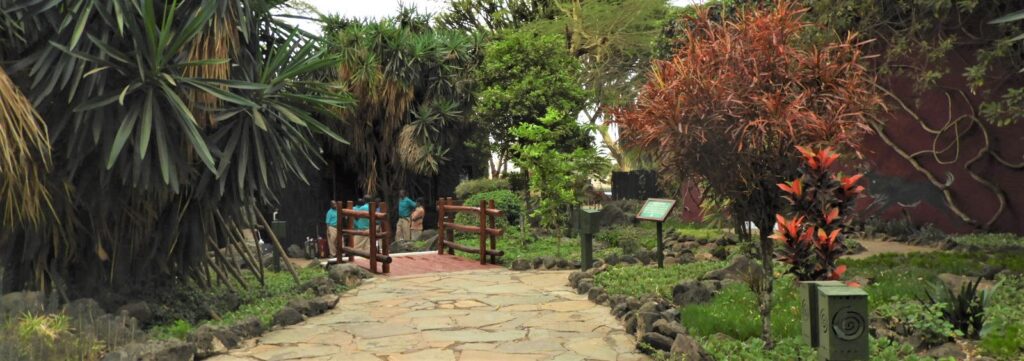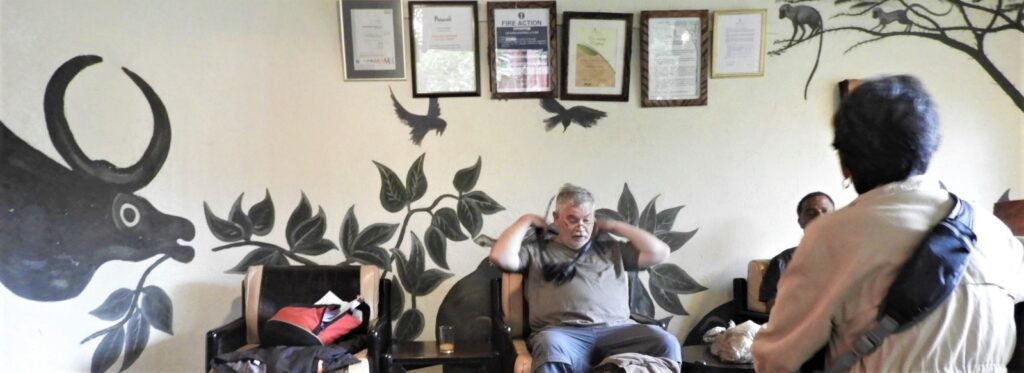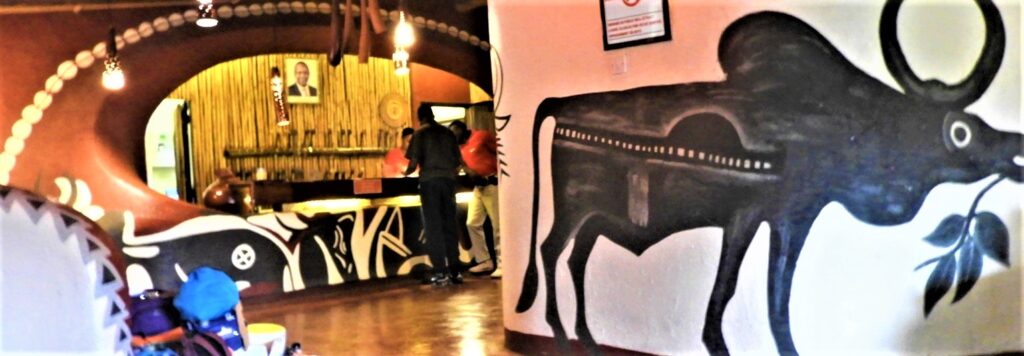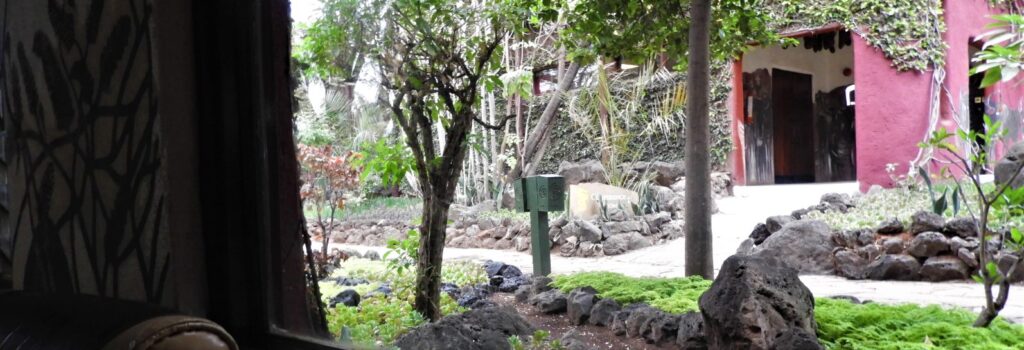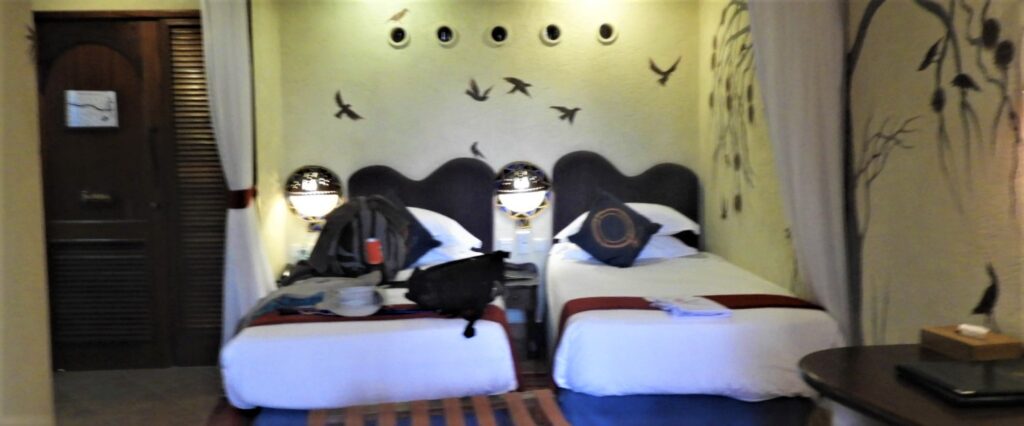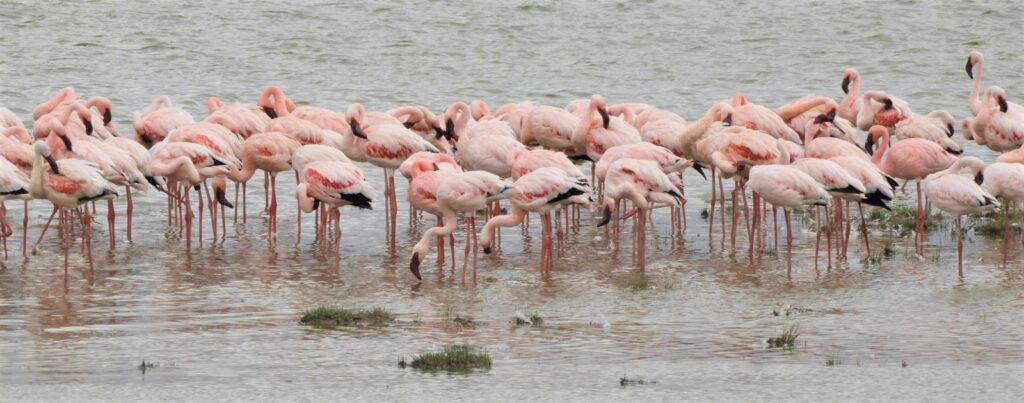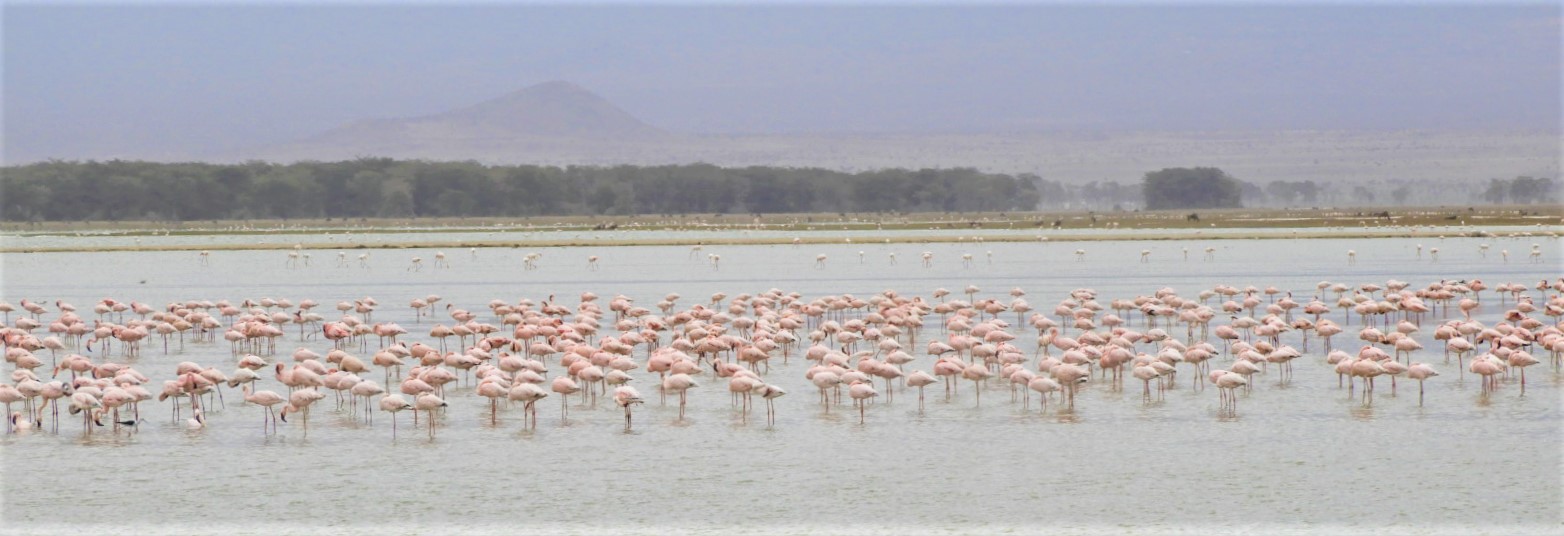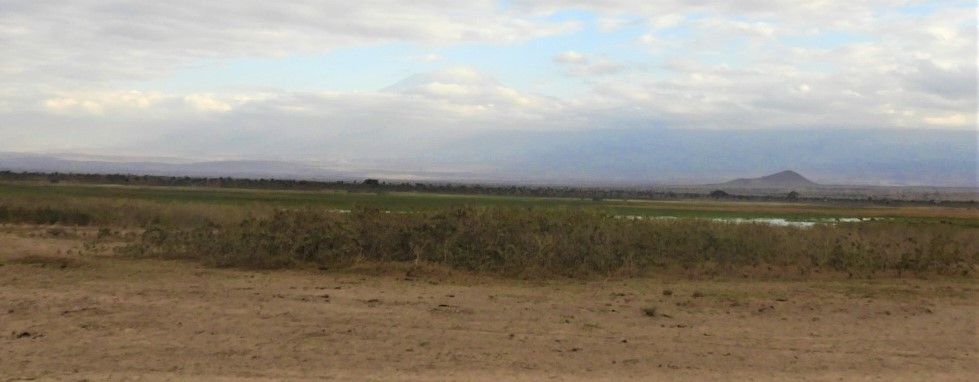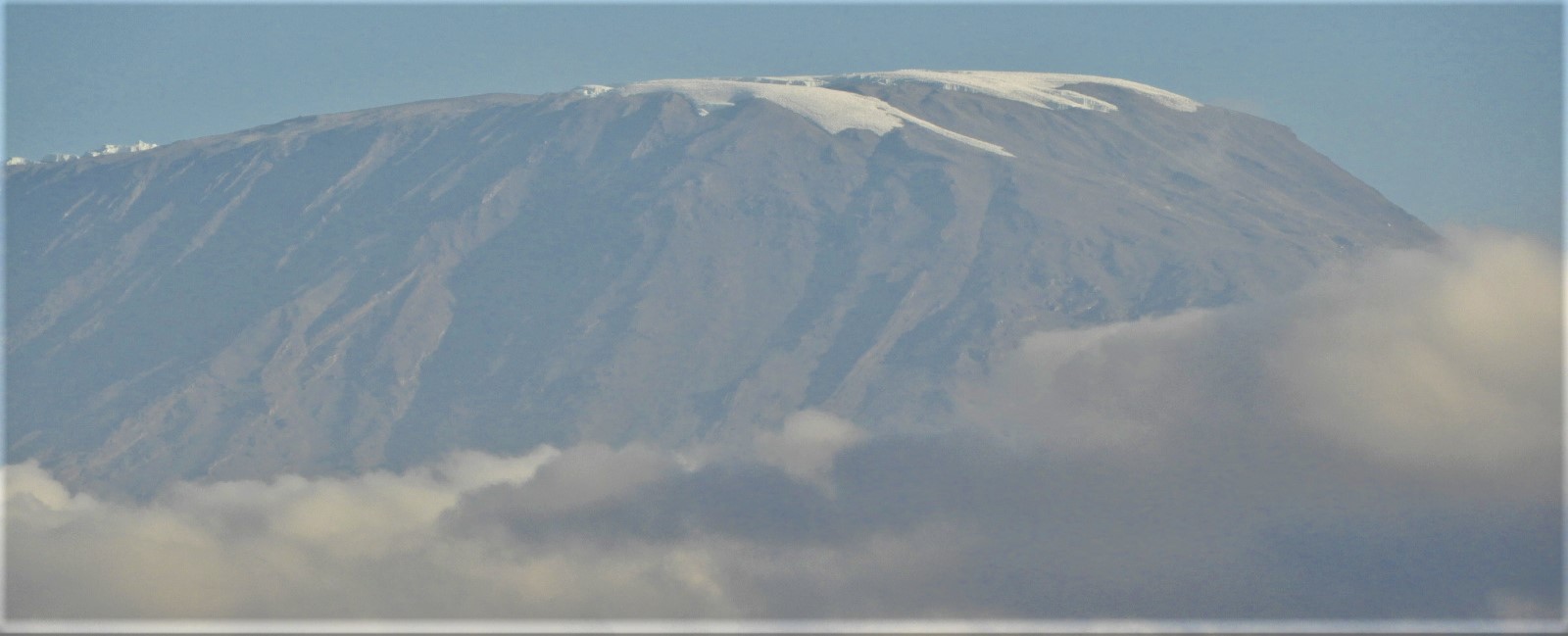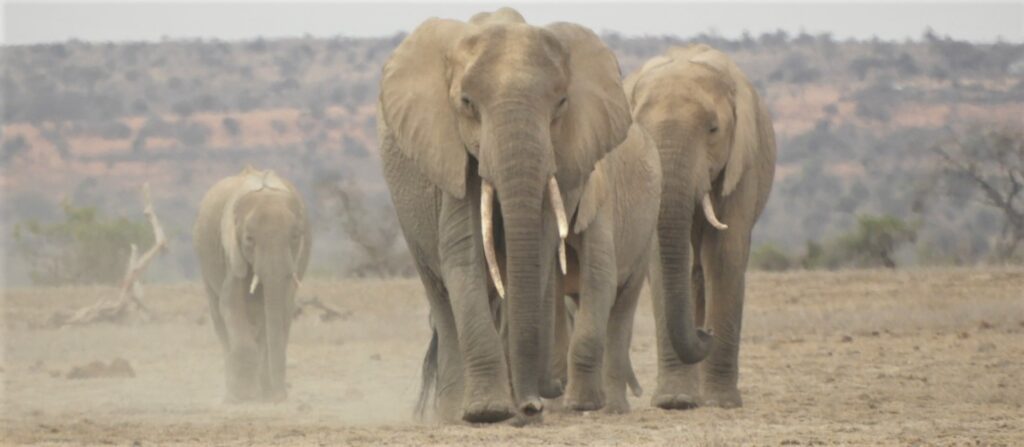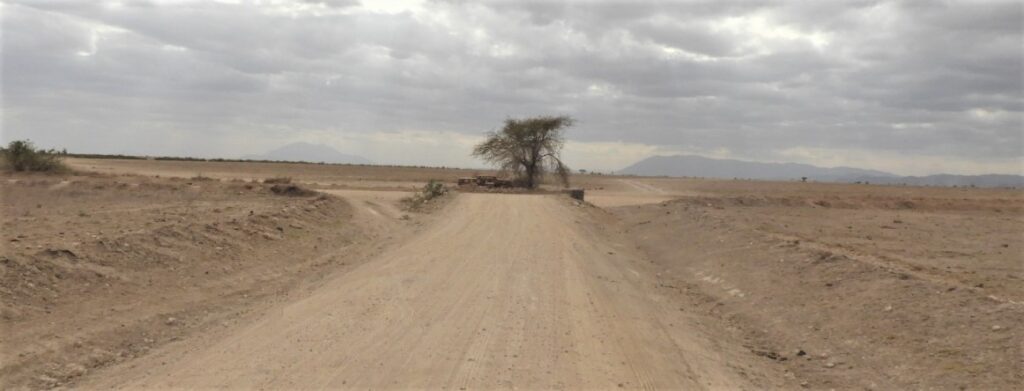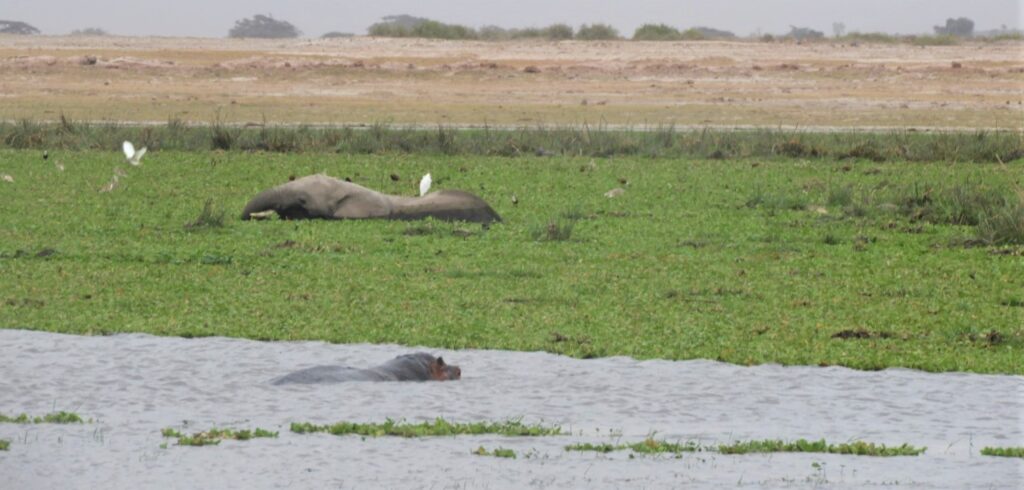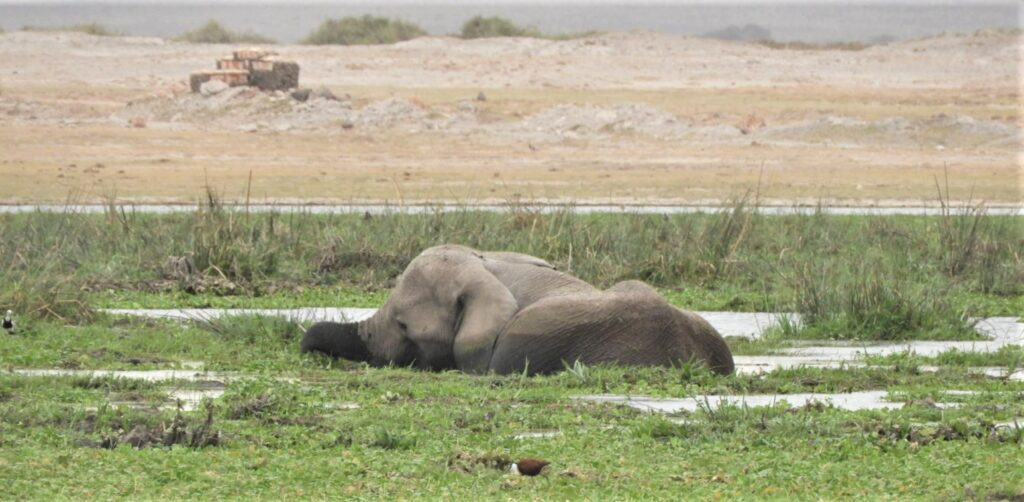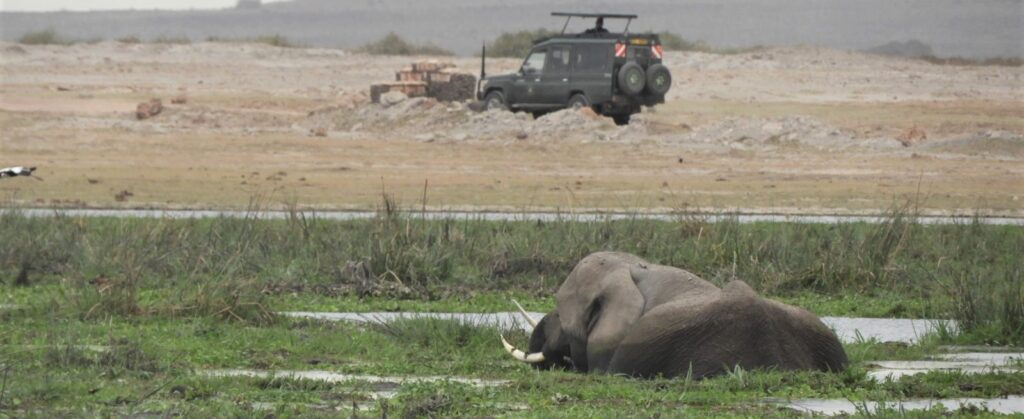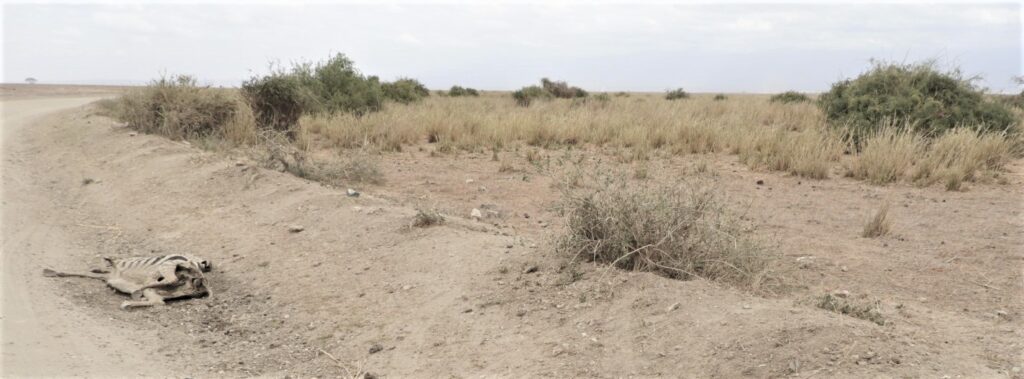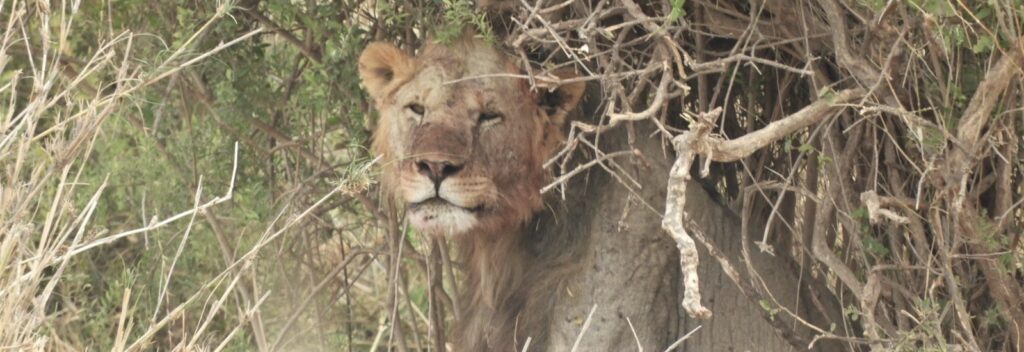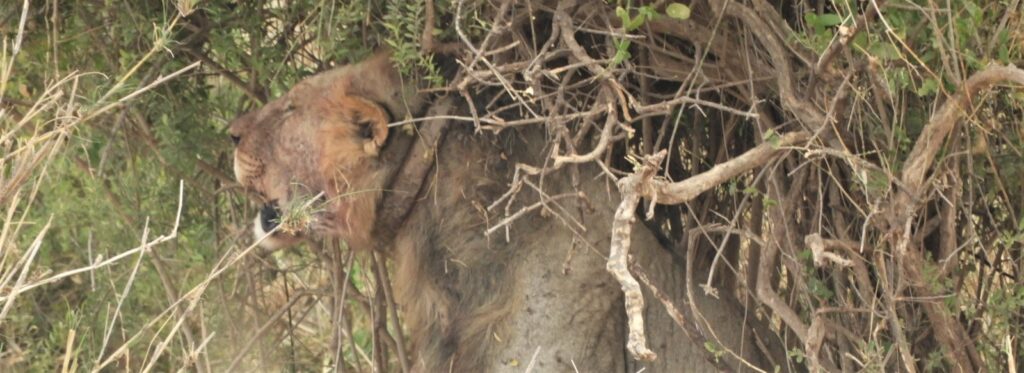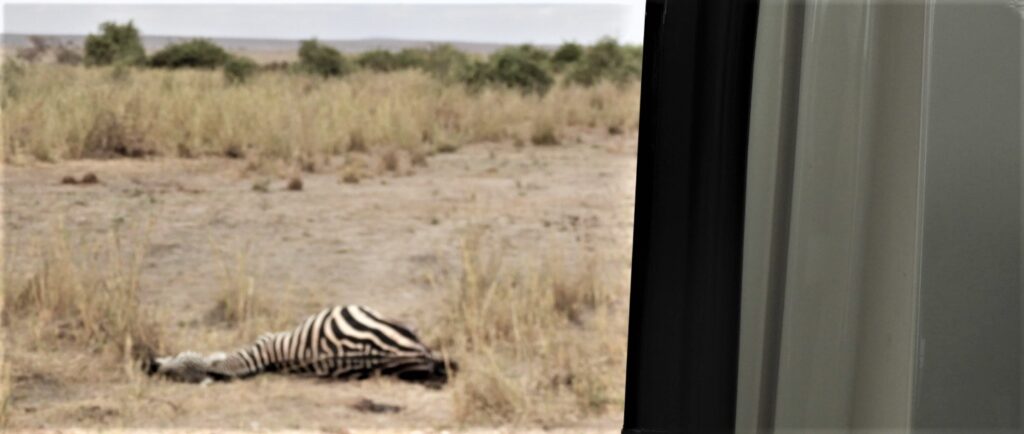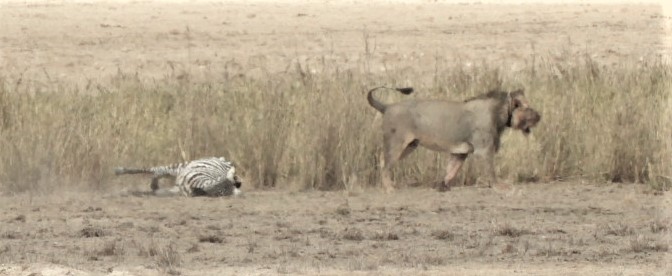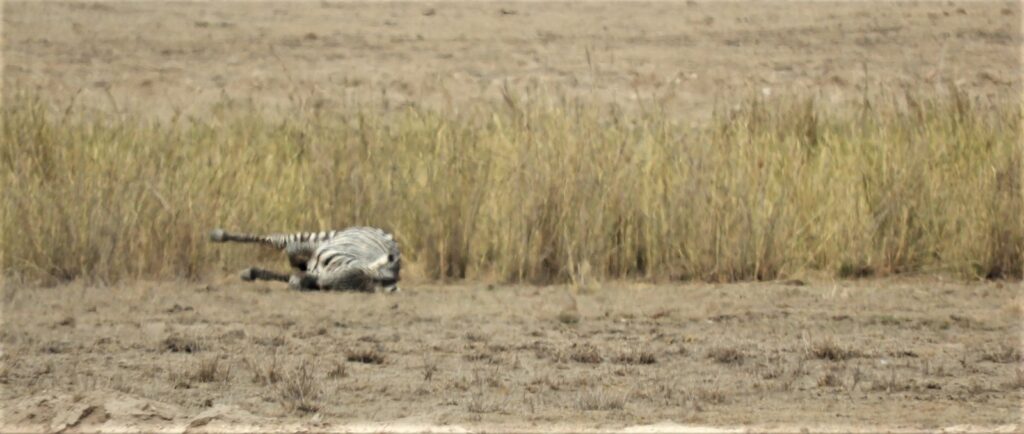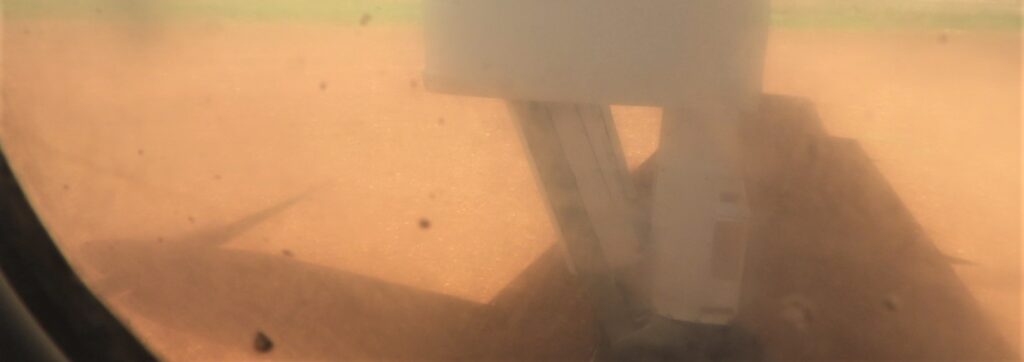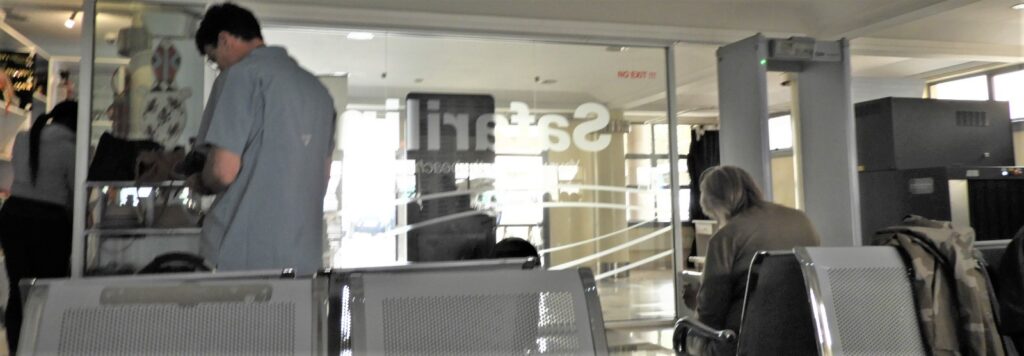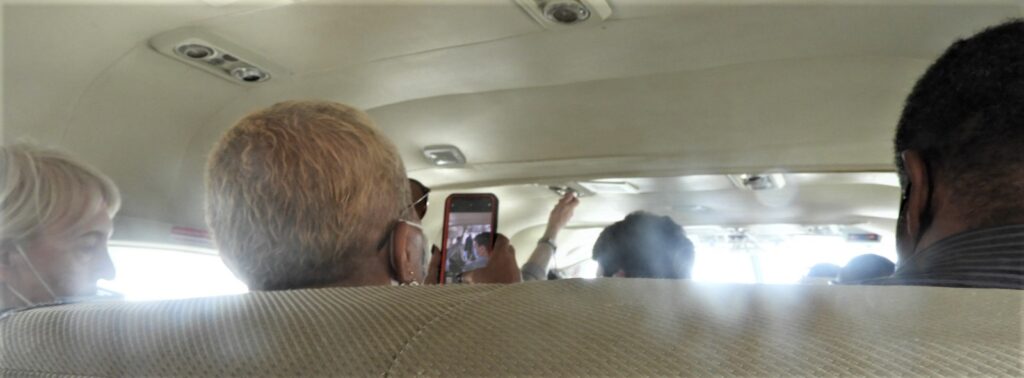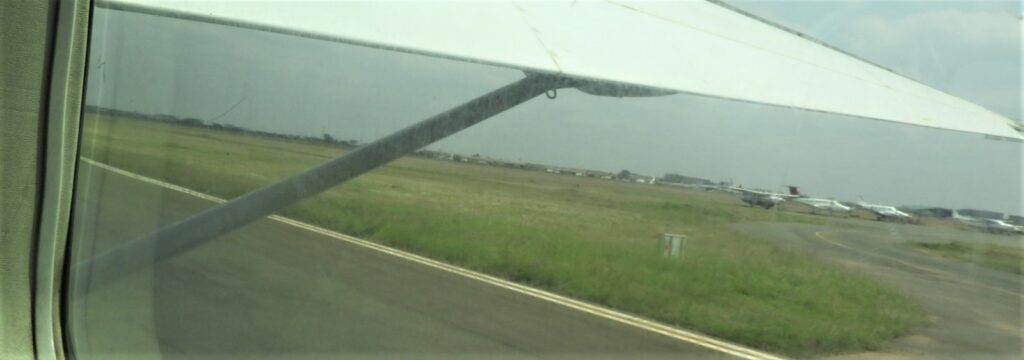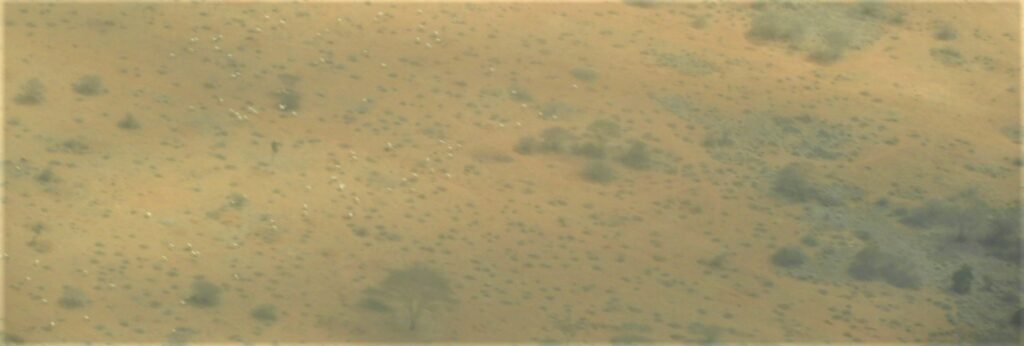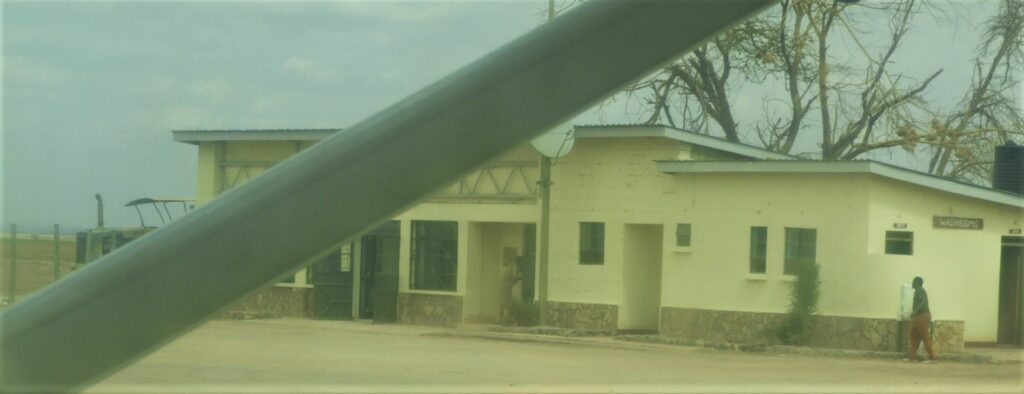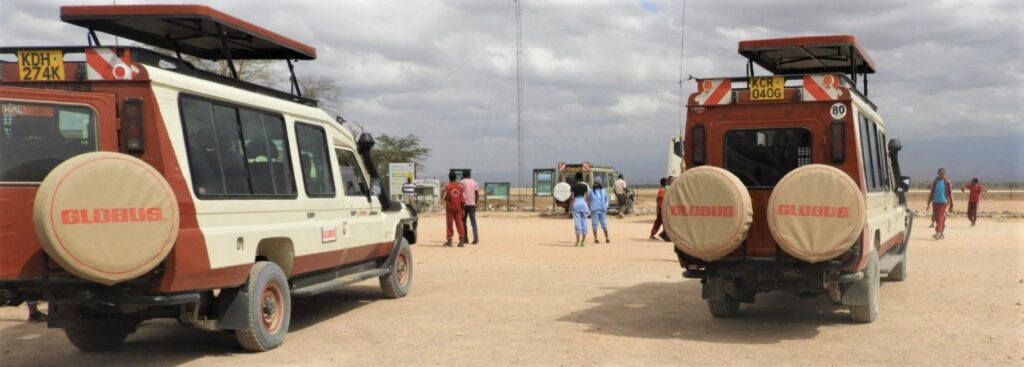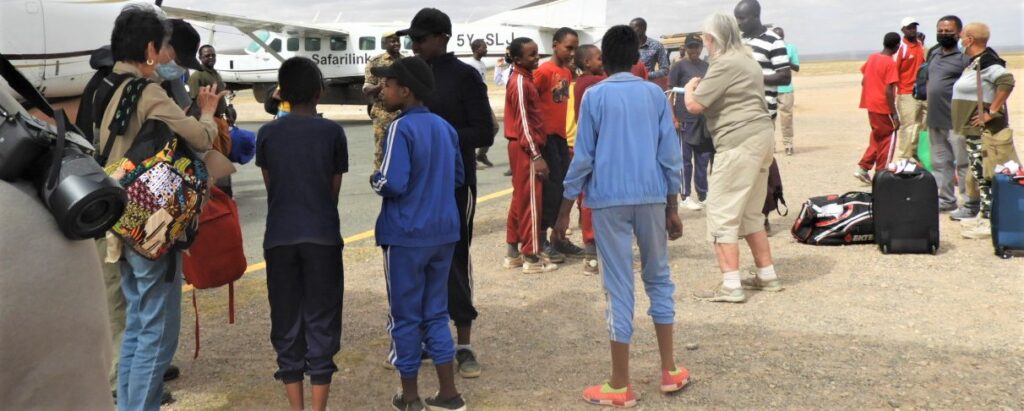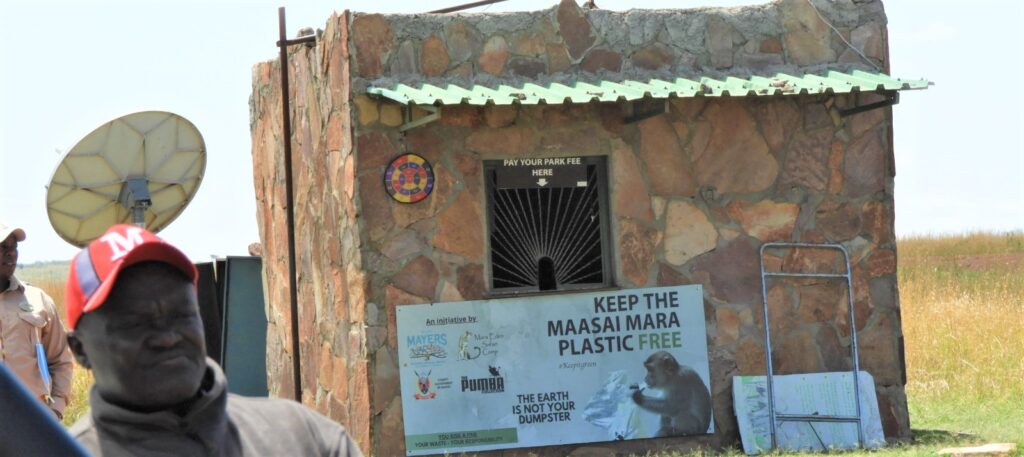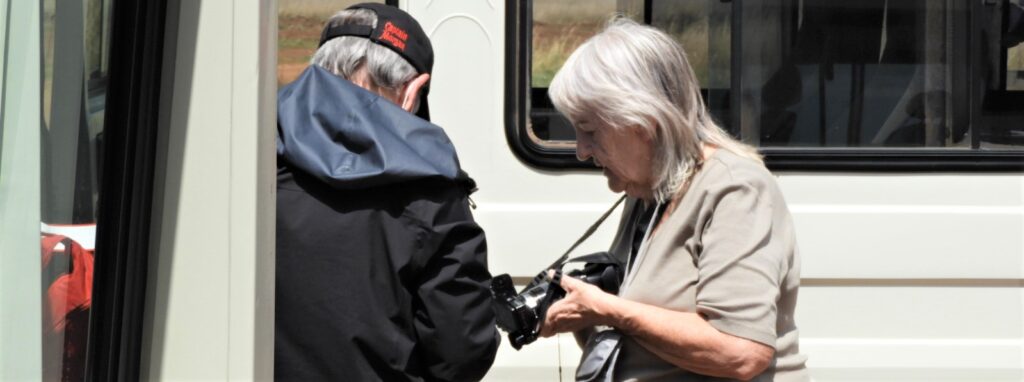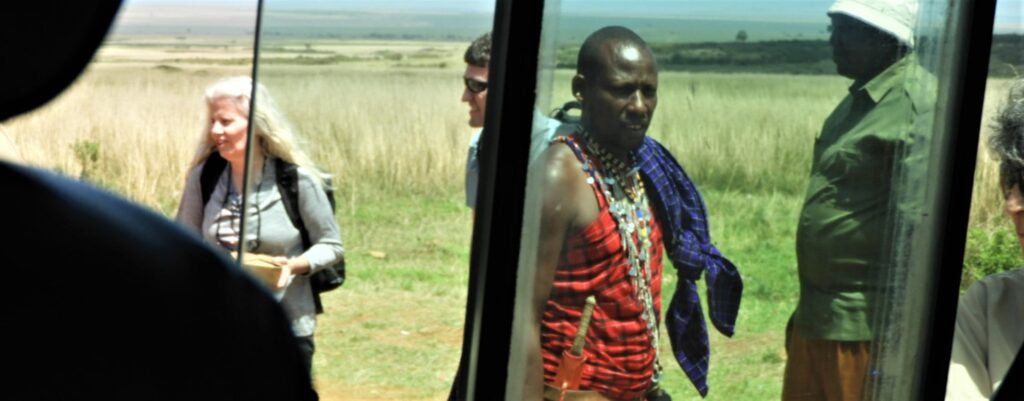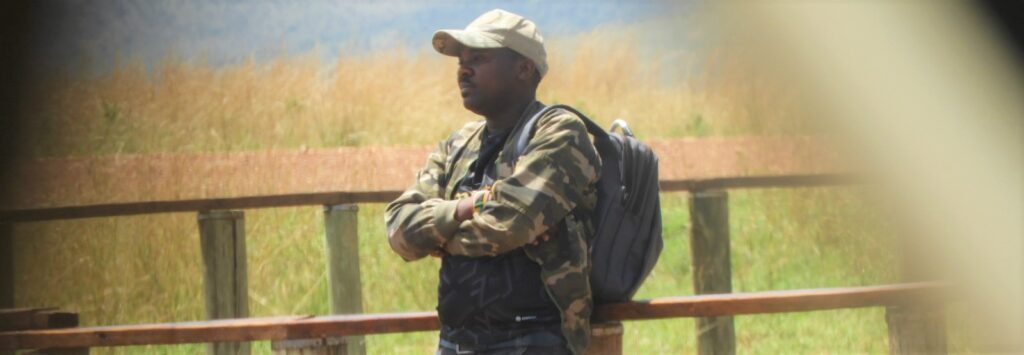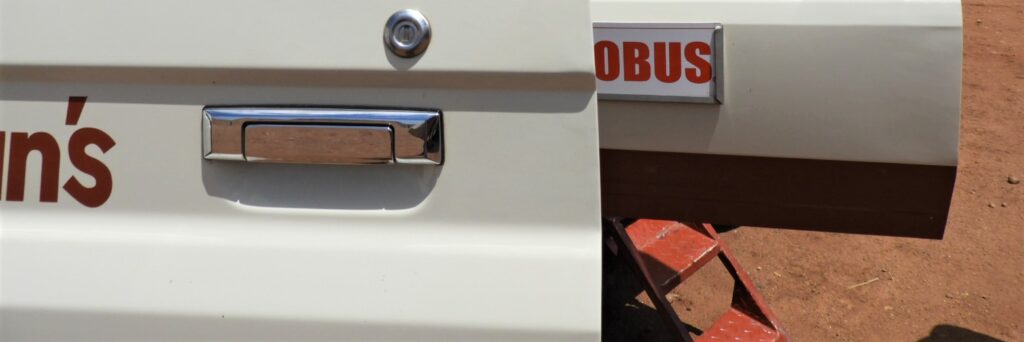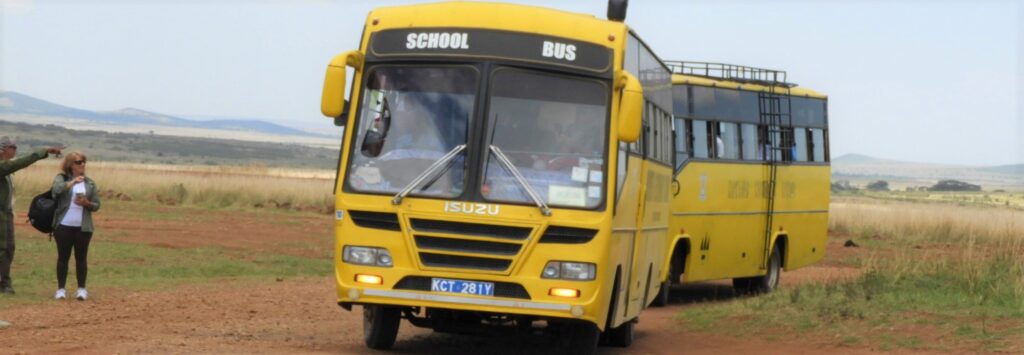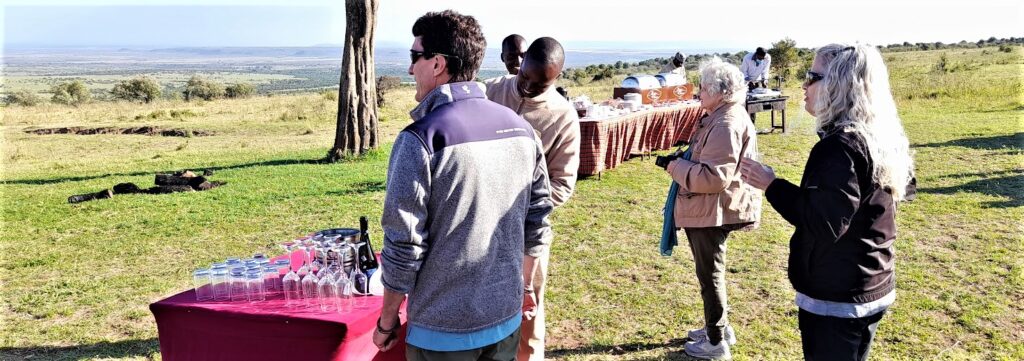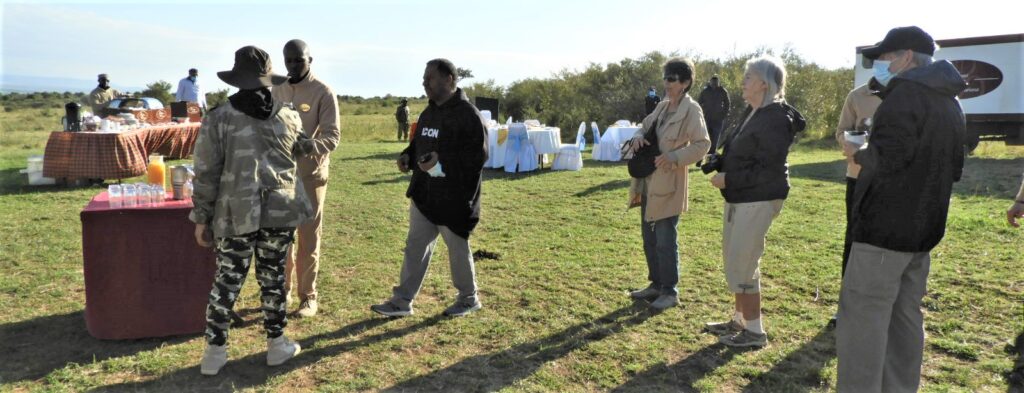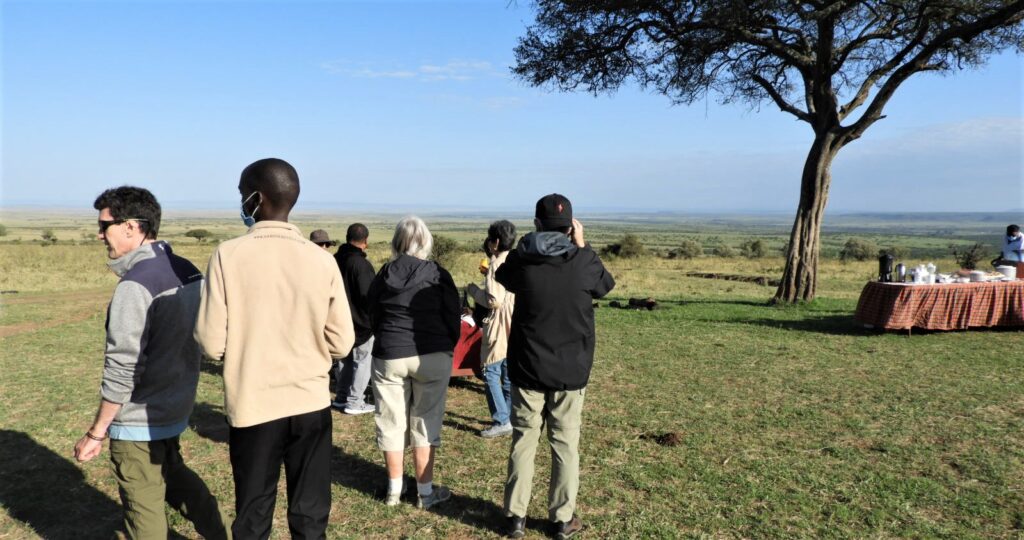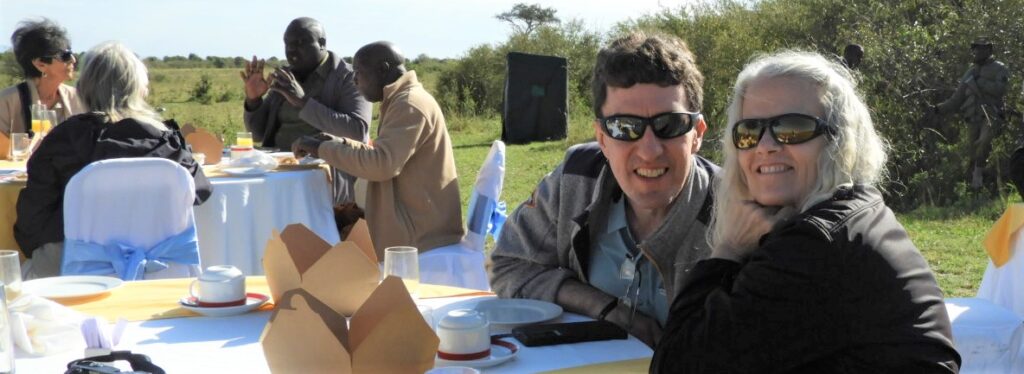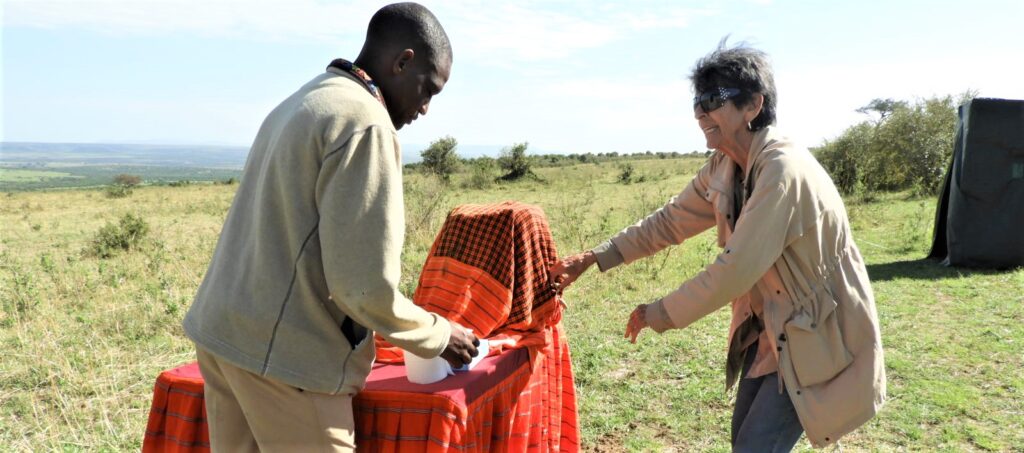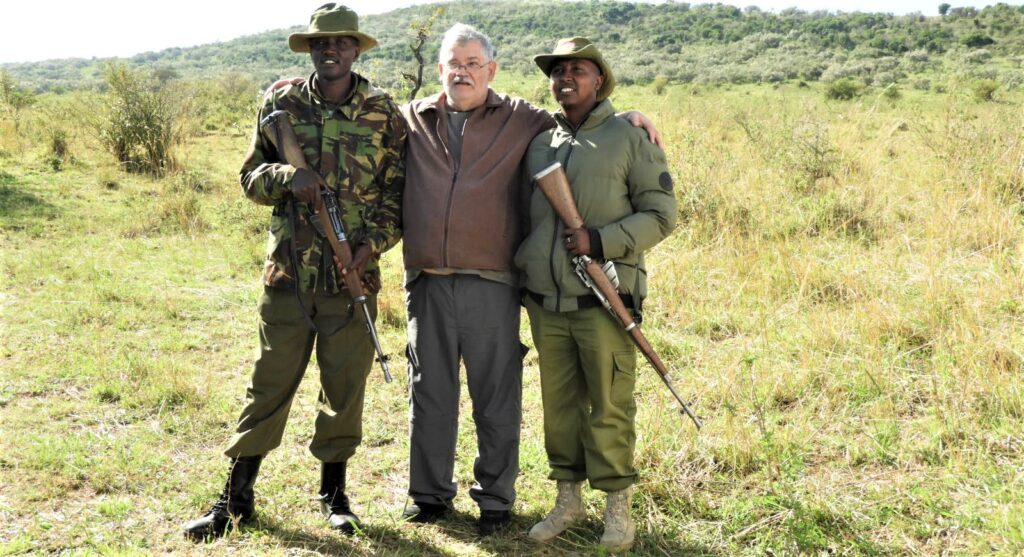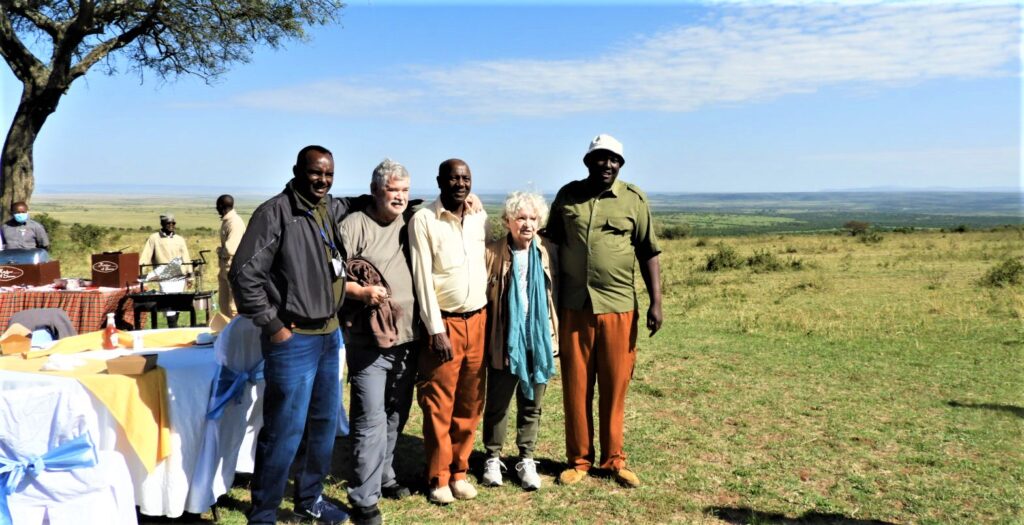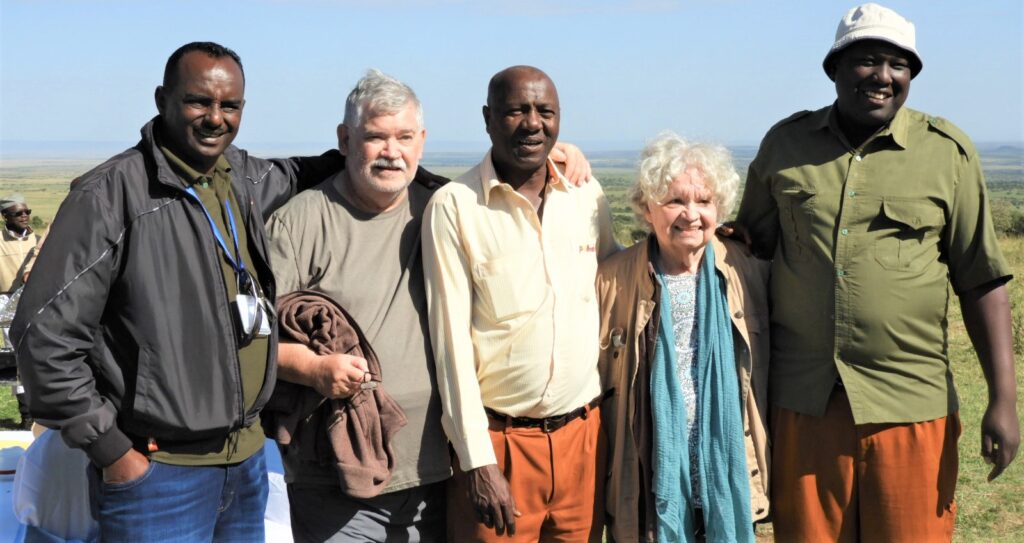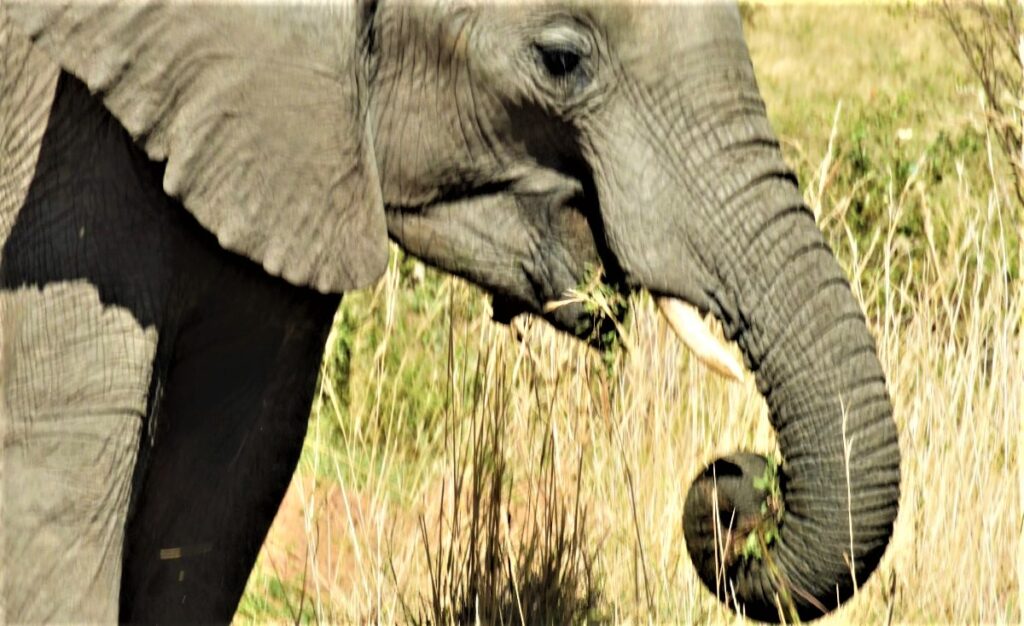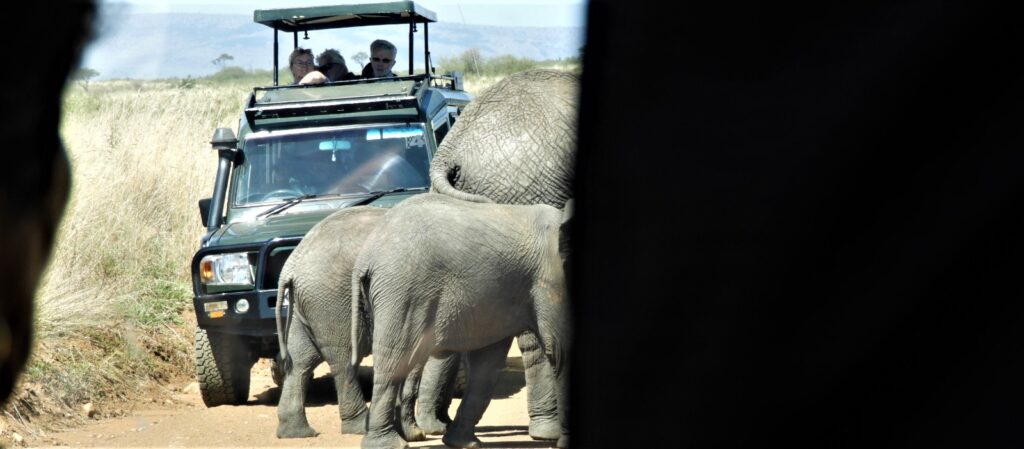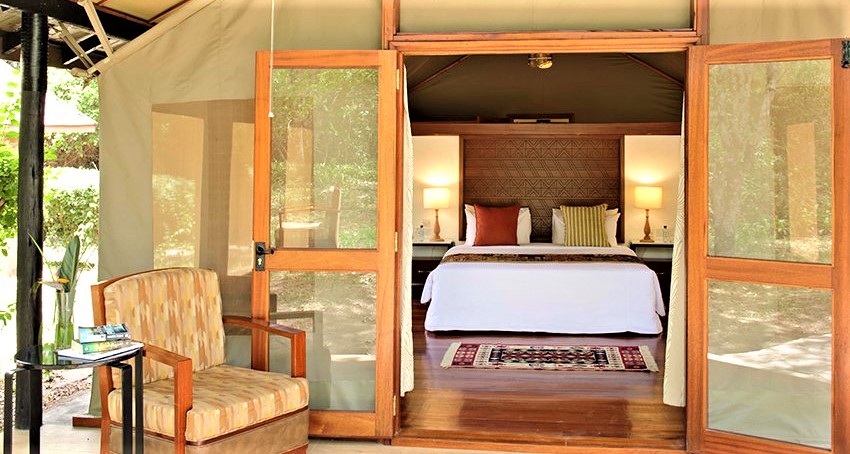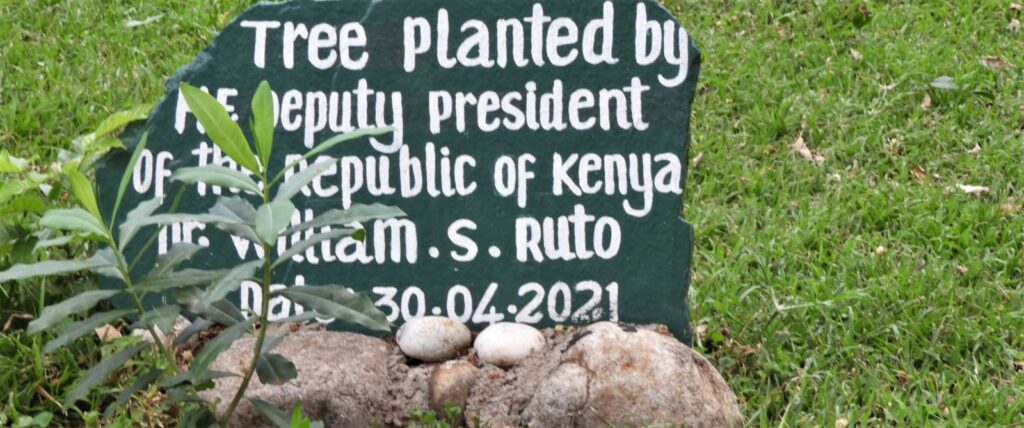Archive for September 17th, 2022
» posted on Saturday, September 17th, 2022 by Linda Lou Burton
Painted Birds
Linda Lou Burton posting from Amboseli Serena Safari Lodge, Amboseli National Park, Kenya– It was 6 PM when we arrived, walking zombie-like into our stopping place for the next two nights. Fourteen hours gone since we set our luggage out for pickup at Sarova. Years had passed, it seemed, since our breakfast on that Maasai Mara hill; since we laughed our way through two airport stops, two crowded flights from there to here, this different dusty world with contradictions everywhere.
There were familiars; our gang, assembled once again in a greeting room; Abdi busy at the desk checking us in. The welcome by the staff; new keys; new rooms. Brilliant colors, the Maasai red; lush palms and bright green ferns; vines for real and painted vines; and birds, flying, fluttering; painted on the walls.
Dinner at 7:30 in the dining room, Abdi had advised. Safari cookies at the airport was all I’d had since breakfast, but I could not go. Bone weary, but more than that. I didn’t want to hear another word of gloom. “You go ahead,” I said to Rick; as we dumped belongings in our new room; tiny; twin beds in the corner, mosquito-netted; the corner desk, two bottles of glassed-in water; glass doors to the porch. We’d been instructed about those doors. They must be kept closed or the monkeys will come in and steal our stuff. And never leave anything outside.
Rick washed up, readying for dinner. “Can I bring you anything?” he asked, when he got to the door. “Some soup, and a roll,” I replied. “Doesn’t matter what kind.” Our porch looked out over a swampy spot. I sat there in the quiet till it was dark. Doors closed. 
Amboseli Serena Safari Lodge https://www.serenahotels.com/amboseli
From their website.
Surrounded by the vast and beautiful landscape of Amboseli National Park, Amboseli Serena Safari Lodge provides a full immersion into life in the untamed bush. Each room is housed in a single-story building opening directly onto the grounds, and each reflects a Maasai Manyatta theme with hand-painted wildlife murals, locally inspired furnishings, and the brilliant primary colors symbolic of these fabled warriors. 92 rooms and one suite feature complimentary wireless Internet, 24-hour room service and private balconies.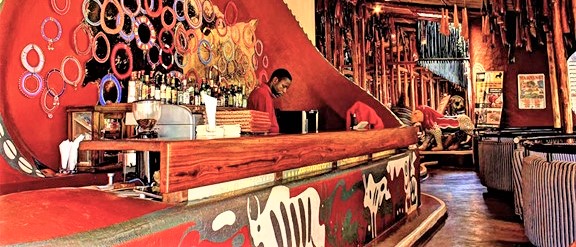
Our central dining area is reached by a timbered bridge spanning a mountain-fed stream and is flanked by water gardens. The walls feature hand-painted wildlife murals and the décor reflects the culture and heritage of the Maasai people. The spacious lounge and bar feature a broad terrace and a blazing fire-pit where evening cocktails can be enjoyed.
» posted on Saturday, September 17th, 2022 by Linda Lou Burton
Future Shock
Linda Lou Burton posting from Amboseli National Park, Kenya– Is this bird a Greater or Lesser Flamingo? Flamingo clues — the Lesser Flamingo is the smallest species of flamingo 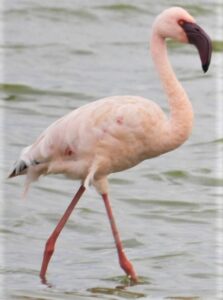 (not the fewest in number). Its plumage is pinkish white; its legs are pink; its beak is black. It stands about 33 inches tall. The Greater Flamingo, it follows, is the largest species of flamingo. Its plumage is pinkish white; its legs are pink; and its beak is pink with a black tip. It stands about 50 inches tall. Since it’s difficult to judge flamingo height when they are knee-deep in lake water and a great distance away from you, I’m focusing on the BEAK. Black, or pink with black tip? I dub this beautiful black-billed bird a member of the Lesser Flamingo species, and a fine specimen at that. We’d finally reached the shallow alkaline lake Amos had promised; it was teeming with birdlife, and dazzlingly colorful, a welcome relief from the brown dust and desolation of the previous hour. The Greater Flamingos (below, note the pink beak with black tip) we found feeding in very different areas of the lake; one which supports grasses, and one a swirl of milky orange, higher in alkalinity.
(not the fewest in number). Its plumage is pinkish white; its legs are pink; its beak is black. It stands about 33 inches tall. The Greater Flamingo, it follows, is the largest species of flamingo. Its plumage is pinkish white; its legs are pink; and its beak is pink with a black tip. It stands about 50 inches tall. Since it’s difficult to judge flamingo height when they are knee-deep in lake water and a great distance away from you, I’m focusing on the BEAK. Black, or pink with black tip? I dub this beautiful black-billed bird a member of the Lesser Flamingo species, and a fine specimen at that. We’d finally reached the shallow alkaline lake Amos had promised; it was teeming with birdlife, and dazzlingly colorful, a welcome relief from the brown dust and desolation of the previous hour. The Greater Flamingos (below, note the pink beak with black tip) we found feeding in very different areas of the lake; one which supports grasses, and one a swirl of milky orange, higher in alkalinity. 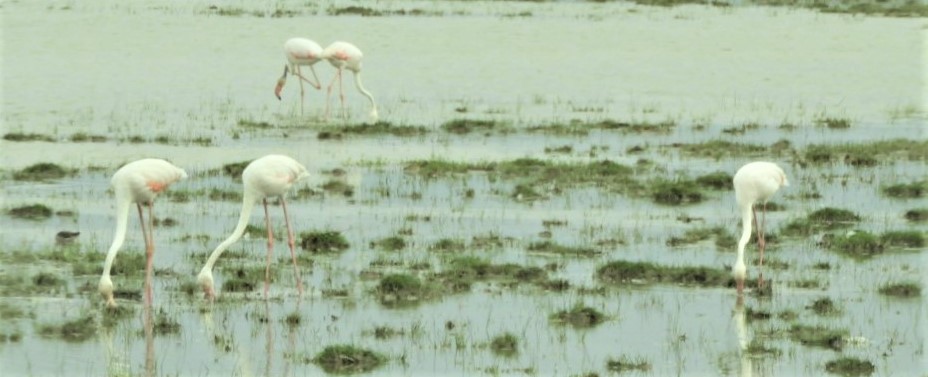
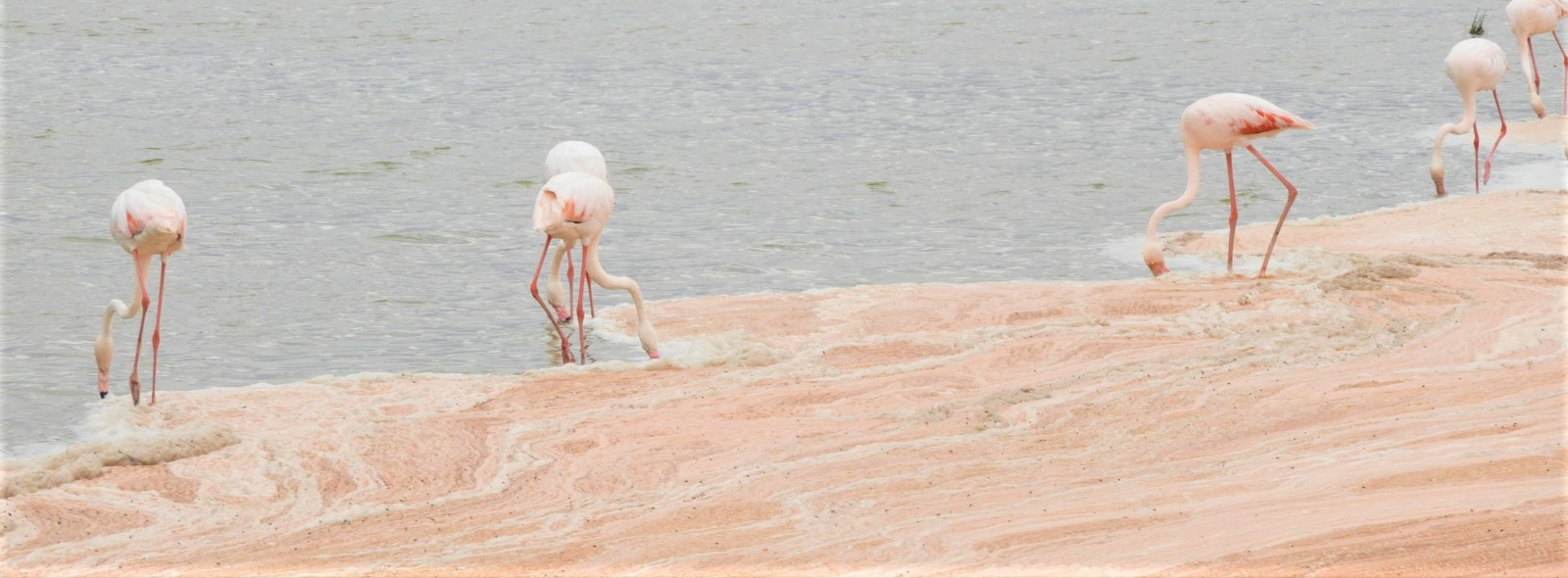 Different areas, different tasty bites? Though both species feed with their heads down, and both eat spirulina, algae which grow in alkaline lakes, their overall food intake is somewhat different due to their beaks. The Lesser Flamingos have such dense filters they can sift out tiny single-celled plants; the Greater Flamingos are able to trap crustaceans and insects with theirs. Does that account, I wondered, for why the Lessers tend to crowd so closely together?
Different areas, different tasty bites? Though both species feed with their heads down, and both eat spirulina, algae which grow in alkaline lakes, their overall food intake is somewhat different due to their beaks. The Lesser Flamingos have such dense filters they can sift out tiny single-celled plants; the Greater Flamingos are able to trap crustaceans and insects with theirs. Does that account, I wondered, for why the Lessers tend to crowd so closely together?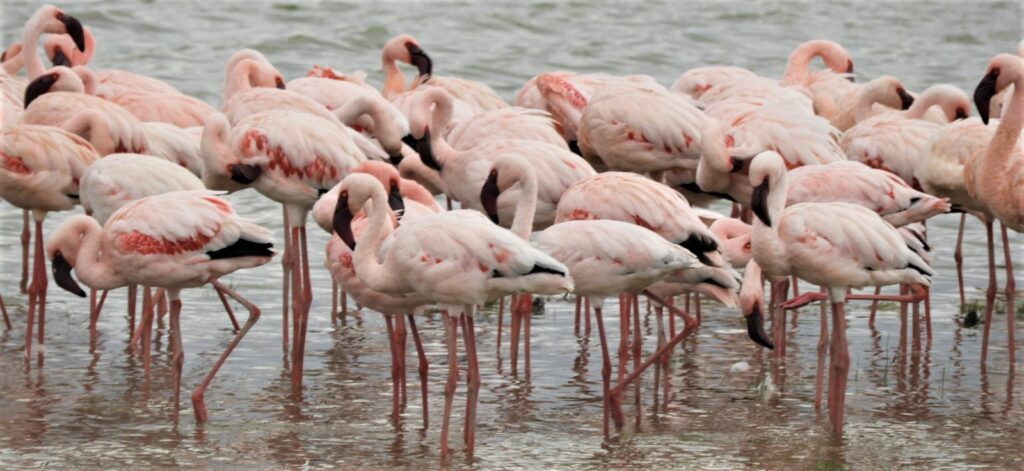
We were parked by the solemn Undertaker Bird when the clouds began to break over Mt Kilimanjaro. Our vision shifted as Amos directed our attention beyond the birds; the few wildebeests grazing; the cluster of trees. Was there enough food, and water, after all? “Some of those trees are fenced to protect them from elephants,” Amos told us. “It’s a reforestation program; too many trees were cut over too many years. These need time to grow. But now we’re in our fourth year of serious drought. The long rains haven’t come to replenish the water in the shallow lakes. Or the snow on Mt Kili. Without fresh snow on the mountain, there is no water flowing to the underground springs, and the swamps will eventually dry up. The trees will die. The animals will die. The flamingos will leave. All of this will be gone.”
Scientists predict all glaciers on East Africa’s 19,341-foot Mt Kilimanjaro will be gone by the year 2030. Climate change has brought about more rapid glacier melt and also impacted rain and snowfall patterns. Note evidence of glacier disappearance in the last ten years: the photo below was taken in 2012; the one above was taken by me on the afternoon of September 17, 2022.
Amboseli National Park https://amboseli.com/
» posted on Saturday, September 17th, 2022 by Linda Lou Burton
A Strange Land
Linda Lou Burton posting from Amboseli National Park, Kenya– “An elephant can eat 600 pounds of food a day,” Amos told us. We’d just passed a splintered tree, damaged by 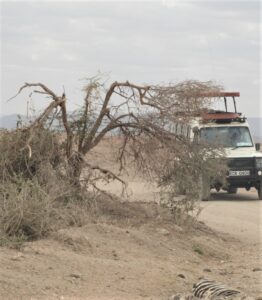 elephants, we were told, as Amos turned the 4×4 to go further into the park. Another zebra carcass there; our companion 4×4 was turning too. Amos explained more about Amboseli as we continued on the drive; a place famous for its elephants. I remembered the sign plastered on our plane today “Hands Off Our Elephants.” “Are the elephants dying of thirst too?” I asked. “No” was his answer; “that sign refers to poachers. But a serious crackdown on poaching has greatly reduced the numbers killed by human hands. So the elephant population is increasing here. More elephants means the food supply is more in demand, and now, due to the drought, that is fast being depleted. And since the snow cap on the mountain is disappearing, the water supply is disappearing too.” Just then, a rumbling sound; elephants, moving fast. We stopped to watch; the dust, the thundering intensity. Serious in purpose, mothers and children, looking for food, for daily sustenance. They passed us by, were gone, no need to stop, nothing here.
elephants, we were told, as Amos turned the 4×4 to go further into the park. Another zebra carcass there; our companion 4×4 was turning too. Amos explained more about Amboseli as we continued on the drive; a place famous for its elephants. I remembered the sign plastered on our plane today “Hands Off Our Elephants.” “Are the elephants dying of thirst too?” I asked. “No” was his answer; “that sign refers to poachers. But a serious crackdown on poaching has greatly reduced the numbers killed by human hands. So the elephant population is increasing here. More elephants means the food supply is more in demand, and now, due to the drought, that is fast being depleted. And since the snow cap on the mountain is disappearing, the water supply is disappearing too.” Just then, a rumbling sound; elephants, moving fast. We stopped to watch; the dust, the thundering intensity. Serious in purpose, mothers and children, looking for food, for daily sustenance. They passed us by, were gone, no need to stop, nothing here. 
The road ahead stretched long, the dust as far as I could see. “Where is water?” I asked, wondering about the mountain top, the melting ice. Wondering about the dust surrounding me. “The swamps,” was the reply, “the fresh-water swamps, created from the springs. The snow melt sinks into the ground on the mountain, emerges on the plain as swamps.” I’d only known Amos an hour. He was thoughtful, and intelligent, I could tell. But could we believe this man who was a stranger to us, here in this strange land? I pressed for more. “Swamps in all this dust? How can that be?” “You’ll see,” he said, and suddenly, there they were. Water holes, filled with marshy greens, and hippos, and birds. And elephants, eyeball deep in water. Just feet away, more dust. Like crazy mirrors in an amusement park, distorting everything, illusion, or reality? The day would get stranger still, we were soon to see. 
Factoids about Amboseli: The word “Amboseli” is an English corruption of the Maasai Maa word “Empusel” meaning “salty dust.” The area is classified as semi-arid savanna. Melting snows and rainfall on Mt Kilimanjaro percolate through the porous soil into an extensive subterranean aquifer reemerging in the basin as permanent swamps. Two large swamps, Longinye and Enkongo Narok, transect the basin and numerous smaller swamps surface in the central and western parts of the park, home to a myriad of species of animals. During the long rains between March and April, the dry plain can become a shallow lake, filled with wading birds (there are 400 species here alone).
Next post: The strange shallow lake and the wading birds.
Amboseli National Park https://amboseli.com/
» posted on Saturday, September 17th, 2022 by Linda Lou Burton
The Kill
Linda Lou Burton posting from Amboseli National Park, Kenya–“That’s another one dying  of thirst,” Amos said. “They get so weak they can barely move.” Amos was our new driver; we’d assembled in our vehicle the same way as we did before – Rick and me third row back, behind Otis and Venita. Abdi was in the other 4×4 with the rest of the gang. Amos was straightforward in his approach, giving us facts about Amboseli in a quietly scientific way. Maybe that’s what it took, seeing what he saw every day. Stay unemotional, stay sane. Record the facts. Report on what’s happening. And what’s happening is — animals are dying of thirst. We’d fallen into a state of shock since leaving the airport twenty minutes ago. All we were seeing was dust. Flat plains, and dust. None of us expected this; only hours before we’d been on the lush plains of the Maasai Mara, where everything was green and animals grazed peacefully side by side. The zebra before us now didn’t fit the pattern in our minds; something was off. It was about to get worse. Amos drove on. “There’s one that died,” he said, just as I spotted a zebra carcass on the ground. “You can tell it wasn’t a kill because of how it lays. Every day is like Christmas for the lions these days. They don’t even have to hunt.”
of thirst,” Amos said. “They get so weak they can barely move.” Amos was our new driver; we’d assembled in our vehicle the same way as we did before – Rick and me third row back, behind Otis and Venita. Abdi was in the other 4×4 with the rest of the gang. Amos was straightforward in his approach, giving us facts about Amboseli in a quietly scientific way. Maybe that’s what it took, seeing what he saw every day. Stay unemotional, stay sane. Record the facts. Report on what’s happening. And what’s happening is — animals are dying of thirst. We’d fallen into a state of shock since leaving the airport twenty minutes ago. All we were seeing was dust. Flat plains, and dust. None of us expected this; only hours before we’d been on the lush plains of the Maasai Mara, where everything was green and animals grazed peacefully side by side. The zebra before us now didn’t fit the pattern in our minds; something was off. It was about to get worse. Amos drove on. “There’s one that died,” he said, just as I spotted a zebra carcass on the ground. “You can tell it wasn’t a kill because of how it lays. Every day is like Christmas for the lions these days. They don’t even have to hunt.”
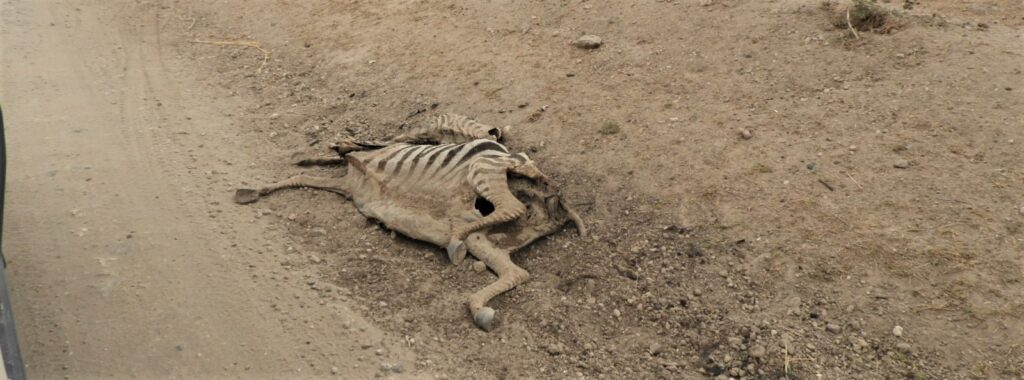 There were bushes by the roadside; Amos suspected a lion sheltering there, and he was right. We watched as the lion stretched, sat up, and stared; bored, it seemed. Thinking of something to do next? He stretched again, then stood, and ambled out, heading for the open field.
There were bushes by the roadside; Amos suspected a lion sheltering there, and he was right. We watched as the lion stretched, sat up, and stared; bored, it seemed. Thinking of something to do next? He stretched again, then stood, and ambled out, heading for the open field.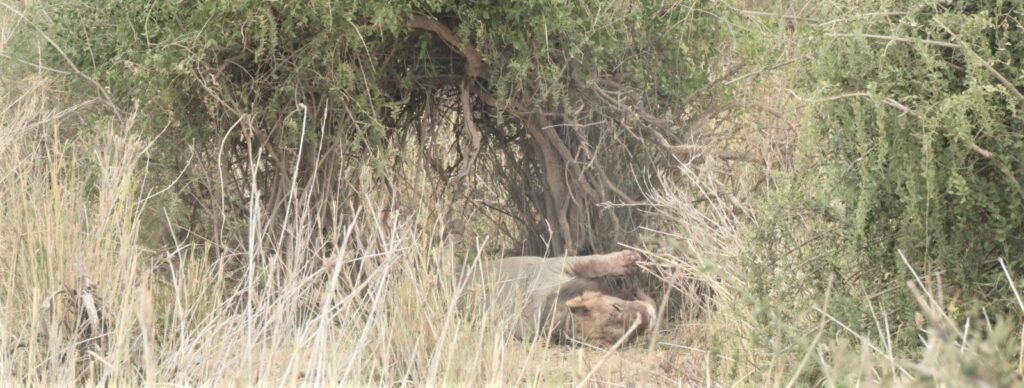
Amos backed the 4×4, turned to track the lion. Around another curve lay zebra bones picked clean, a death from other days. Another zebra carcass then, more freshly fallen. Past the bushes to an open space; the 4×4 was in position now. We watched the lion.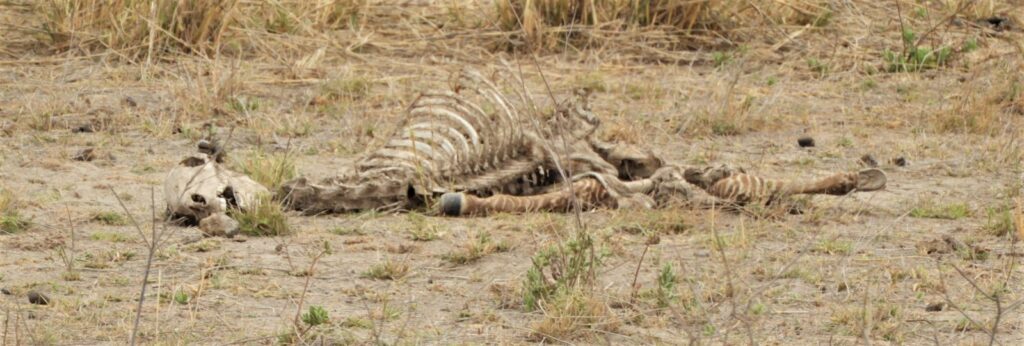
A zebra standing in the dust. The lion approached, a slow-stroll walk across the field. The zebra did not move. “He can’t,” said Amos. “He is exhausted.” Venita softly crying then, the rest of us sat mesmerized. The lion struck. The zebra fell. The lion turned, and walked away. The zebra kicked two times, and died.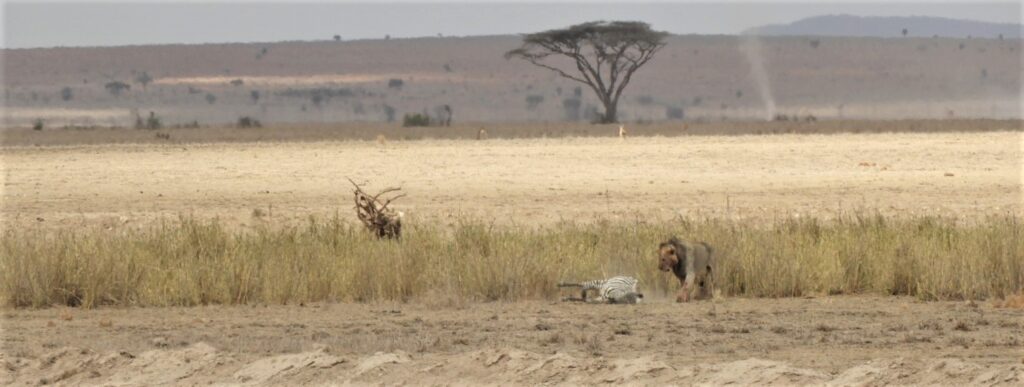
Note: As you can see, I did not get a photo of the kill itself. I was, in truth, paralyzed, and could not think of my camera at that moment. This was the beginning of our three-hour game drive in Amboseli National Park on the afternoon of September 17. The next two posts are as sharply disturbing as this one; it was an afternoon that shook us all.
The story of the elephants is next.
Amboseli National Park https://amboseli.com/
» posted on Saturday, September 17th, 2022 by Linda Lou Burton
Pass The Windex
Linda Lou Burton posting from Amboseli Airport, Amboseli National Park, Kenya–– It was 11:45 by the time was were looking at the Fasten Seat Belt sign. Did our luggage get on? 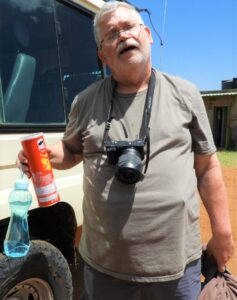 Sometimes you just have to trust the gods. On safari planes, only one bag of soft-sided luggage weighing no more than 33 pounds allowed, absolute! So everything else we crammed into our one allowable backpack, or wrapped around our neck, or slung over our arm, nothing neat about it. Rick had his water bottle hanging from a finger, his can of Pringles in hand (his Pringles a running joke like my bottle of Coke). See his money belt making a bulge under his shirt? Advertisement for a mugging, my opinion, mine tucked safely underneath the waistband of my pants. My water bottle was tucked in the side pocket of my backpack; my jacket ON. But then, I had CANE in my hand, which didn’t help a bit climbing the fold-down steps to get inside the plane with no Daniel assisting, (pole, pole). Despite the inconveniences, lift-off happened, yea, now to see the Great Rift Valley from above, free and easy as a bird! Wishful thinking, Linda Lou. Shucks, I didn’t count on dirty windows.
Sometimes you just have to trust the gods. On safari planes, only one bag of soft-sided luggage weighing no more than 33 pounds allowed, absolute! So everything else we crammed into our one allowable backpack, or wrapped around our neck, or slung over our arm, nothing neat about it. Rick had his water bottle hanging from a finger, his can of Pringles in hand (his Pringles a running joke like my bottle of Coke). See his money belt making a bulge under his shirt? Advertisement for a mugging, my opinion, mine tucked safely underneath the waistband of my pants. My water bottle was tucked in the side pocket of my backpack; my jacket ON. But then, I had CANE in my hand, which didn’t help a bit climbing the fold-down steps to get inside the plane with no Daniel assisting, (pole, pole). Despite the inconveniences, lift-off happened, yea, now to see the Great Rift Valley from above, free and easy as a bird! Wishful thinking, Linda Lou. Shucks, I didn’t count on dirty windows.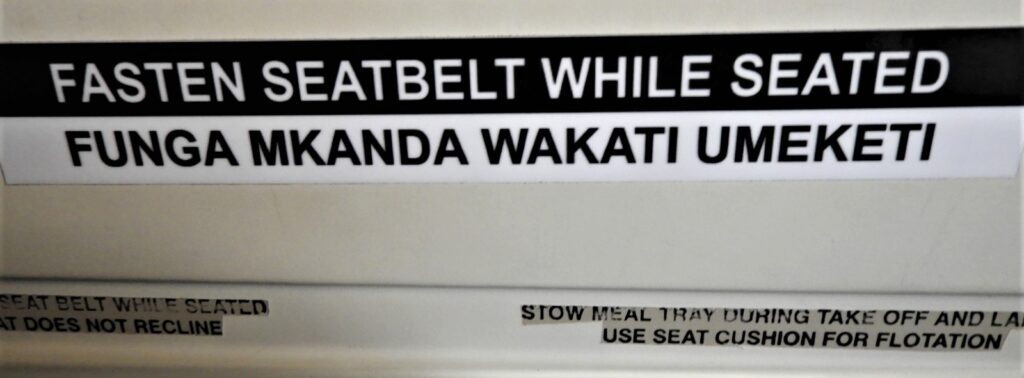
According to the MAP, we flew over the Olorgesailie Prehistoric Site on the floor of the Great Rift Valley; it’s between two extinct volcanoes, Mt Olorgesailie and Oldonyo Esakut. In a lake basin that existed during the latter part of the middle Pleistocene period between 200,000 and 100,000 years ago, discovered by Louis and Mary Leakey in the 1940s! Those Leakeys were all over the place, remember the Lake Nakuru area? We made it to the Wilson Airport in Nairobi in an hour; they had a wheelchair for me, a shiny waiting room, clean washrooms, the works. Those who managed to bring their Bush Breakfast pastry boxes enjoyed a snack; I bought Safari Cookies. “Don’t tell Rick,” I whispered to Lois, “but there is an entire SHELF of Pringles around the corner, in all flavors!” She giggled, and promised to keep mum. We boarded Plane #2 at 2 PM. Oh luggage, please follow. Oh windows, please be cleaner.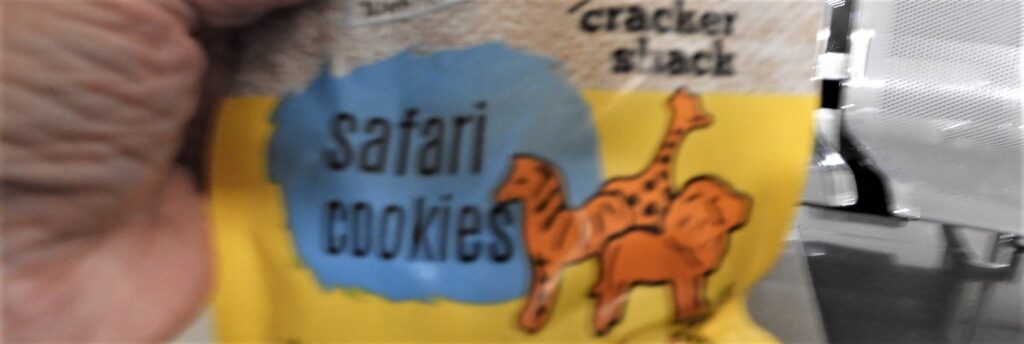
The windows were cleaner! But it didn’t make much difference because, I realized, I didn’t know what I was looking at; oh shucks, again. I spotted a small lake (maybe?); a herd of animals (white dots?); trees, roads, water, dry flats. The flight was smooth, less than an hour to Amboseli Airport. Where I spotted two 4x4s, in Globus colors, just waiting for us.
It was 2:50 PM when we landed; another flurry of excitement; other planes; other people. Dust. I spotted my fancy-schmancy brown-palm-tree suitcase being toted to the pile; tag-sorted to a Globus 4×4; two drivers wearing the familiar Globus orange and green. That suitcase went to Antarctica with me; Gibraltar, Spain; all 50 states. And here I am today, still working on getting a clearer view of things.
Note: Amboseli Airport is in Amboseli National Park in south-central Kenya, close to the international border with Tanzania. Approximately 95 miles south of Jomo Kenyatta International and Wilson Airports in Nairobi, its latitude is 2° 38′ 42.00″S and its altitude 3,757 feet. The single asphalt runway is 3,870 feet. It serves Amboseli National Park.
Amboseli National Park https://amboseli.com/
» posted on Saturday, September 17th, 2022 by Linda Lou Burton
Airports Are For Looking
Linda Lou Burton posting from Keekorok Airstrip, Maasai Mara National Reserve, Kenya–– Which would you choose? Nine hours in a 4×4 across the rugged Rift Valley roads? Or two hours in a plane offering a whole new perspective of Kenya’s magnificent landscape? Globus knew the answer to that; small planes were waiting at Keekorok Airstrip to whisk us nearly 300 miles from the Maasai Mara in western Kenya to Amboseli National Park in the east, within staring distance of Mt Kilimanjaro. Our itinerary allowed for game drives in two parks today, beginning with the Bush Breakfast Extravaganza that already had us pumped. But we were also very sad. It was time to say goodbye to our drivers Daniel and Frank, two of the sweetest guys ever! Abdi would be flying with us, continuing to guide the Kenyan portion of our safari. Daniel and Frank would be driving our vehicles back to Nairobi, readying for a new tour, and new faces, beginning tomorrow.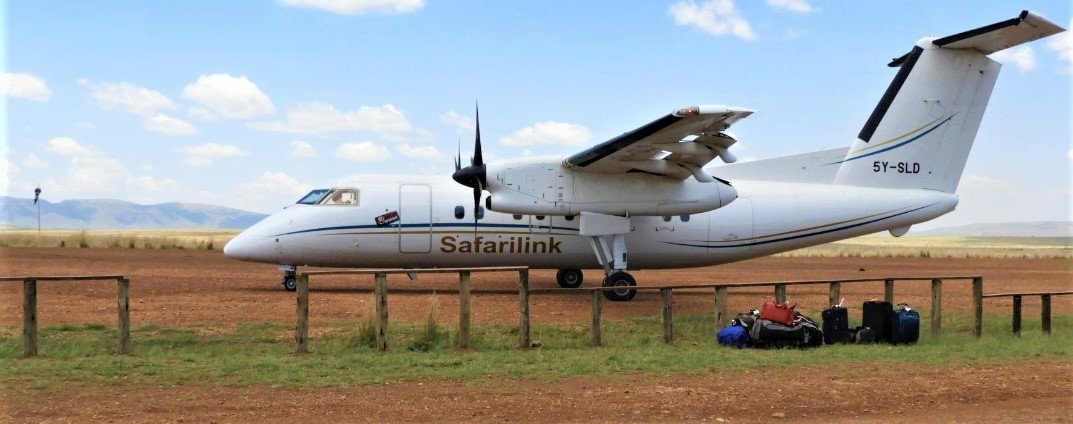
 Rick and I had become attached to Daniel in these last seven days; he was so much more than a good driver, he had become our friend – funny, knowledgeable, and always kind. I never asked a question he wasn’t able to answer — animals, birds, people, places, he just knew! He greeted me every morning with a smile, the ladder-step ready for my ascent into the 4×4; patient as I descended (always last one out) allowing me time to decide which knee would be strongest before I put a foot on the ground. “Knee is thinking,” I’d say, to which he’d reply, “pole, pole, slowly, slowly,” and offer a supporting arm. The Coke he bought for me that first day on the drive from Nairobi north (while everyone else was shopping) had long gone flat (kind of a running joke), but it was still in the 4×4 this morning as Daniel pulled into the melee of confusion surrounding Keekorok Airstrip. “You stay seated in here till the plane arrives,” Daniel said, as everyone else jumped out in a frenzy of activity. “Just look around and enjoy the day.” And so I did.
Rick and I had become attached to Daniel in these last seven days; he was so much more than a good driver, he had become our friend – funny, knowledgeable, and always kind. I never asked a question he wasn’t able to answer — animals, birds, people, places, he just knew! He greeted me every morning with a smile, the ladder-step ready for my ascent into the 4×4; patient as I descended (always last one out) allowing me time to decide which knee would be strongest before I put a foot on the ground. “Knee is thinking,” I’d say, to which he’d reply, “pole, pole, slowly, slowly,” and offer a supporting arm. The Coke he bought for me that first day on the drive from Nairobi north (while everyone else was shopping) had long gone flat (kind of a running joke), but it was still in the 4×4 this morning as Daniel pulled into the melee of confusion surrounding Keekorok Airstrip. “You stay seated in here till the plane arrives,” Daniel said, as everyone else jumped out in a frenzy of activity. “Just look around and enjoy the day.” And so I did.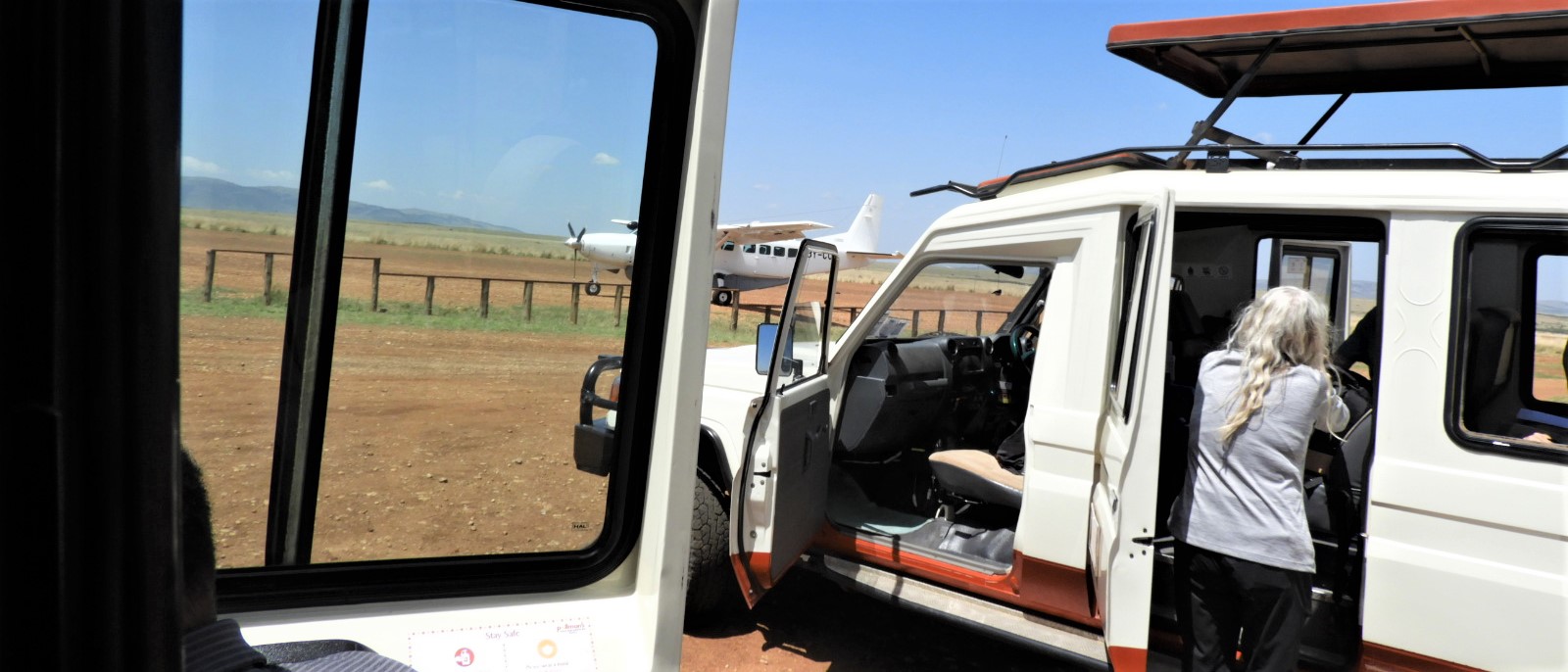
Note: I have been unable to determine the number of lodges and camps in the Maasai Mara and its surrounding conservancies – one source listed the “top 55” so the answer is at least a number higher than that and includes everything from exclusive luxury lodges to the most basic tent camping . There are about ten airstrips serving the lodges and villages in the area. Nairobi is an hour away by plane, a favorite option for tourists, school children, and locals rather than a 6-hour road journey.
 Keekorok Airstrip has one unpaved runway measuring 4,200 feet in length and is situated 5,801 feet above sea level at latitude 1° 35′ 9.00″S. The airstrip mainly serves Keekorok Lodge, Sarova Mara Game Lodge, Sekenani Camp, Mara Sopa Lodge, Mara Topi Safari Lodge, Ashnil Camp and Cottars Camp. Our group stopped at Keekorok Lodge and at Ashnil Camp for rest stops during game drives, both were lovely.
Keekorok Airstrip has one unpaved runway measuring 4,200 feet in length and is situated 5,801 feet above sea level at latitude 1° 35′ 9.00″S. The airstrip mainly serves Keekorok Lodge, Sarova Mara Game Lodge, Sekenani Camp, Mara Sopa Lodge, Mara Topi Safari Lodge, Ashnil Camp and Cottars Camp. Our group stopped at Keekorok Lodge and at Ashnil Camp for rest stops during game drives, both were lovely.
Keep this in mind when you visit the Maasai Mara!
Keekorok Airstrip https://www.masaimara.travel/keekorok-airstrip.php
Sarova Mara Game Camp https://www.sarovahotels.com/maracamp-masai-mara/
Keekorok Lodge https://keekorok-lodge.com/
Ashnil Mara Camp https://www.ashnilhotels.com/mara/
» posted on Saturday, September 17th, 2022 by Linda Lou Burton
Breakfast At Tiffany’s
Linda Lou Burton posting from Sarova Mara Game Camp, Maasai Mara National Reserve, Kenya–– Audrey Hepburn eat your heart out. Diamonds may be dazzling but no place in the breakfast-eating world offers a better start to the day than Observation Hill in the Maasai Mara. I mean! Abdi laid out the plan the evening before. “No breakfast in the dining room tomorrow. We’re having Breakfast in the Bush. Then a short game drive afterwards on the way to the airport.” Our plane was to depart at 11 (or so); Amboseli National Park our next destination. I don’t need words to describe our morning; my pictures should do the trick.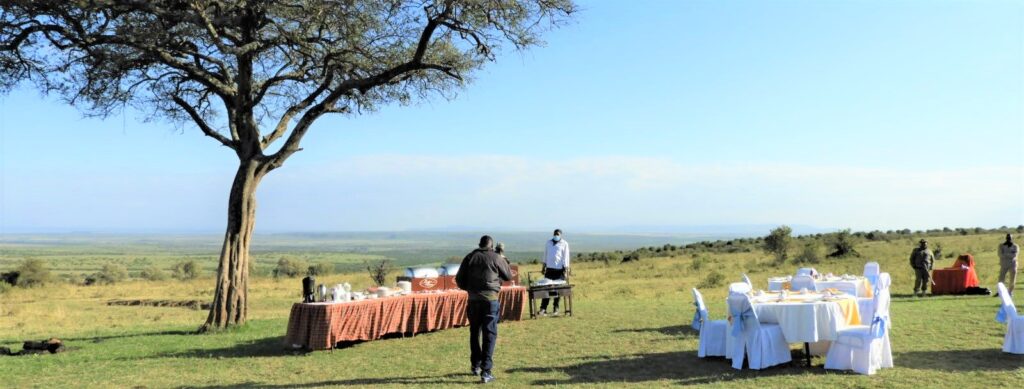
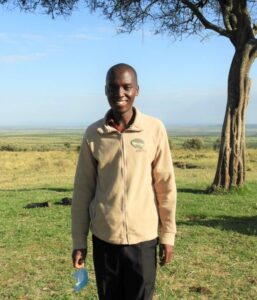 It was a Sarova do, set up early and ready as our 4x4s came over the hill. They thought of everything – chafers of hot foods, grills to cook more, pastries and muffins and boxes for take-away, chilled drinks and hot, white-clothed tables, blue-bowed chairs, a tented potty and proper hand-washing station. Scenery clear to yonder and a blue-perfect sky. Who was there? I was, plus Rick, Otis, and Venita from Daniel’s 4×4; Mike, Lois, Ed, Maureen, and Judy from Frank’s 4×4. Guide Abdi, and all the Sarova staff who cooked and served and greeted and guarded. Yes, two guards with guns watching over us, precaution for our “out of vehicle” status. Isaac, left, is a Sarova employee-in-training who looked after me this morning; we talked about his work and family and life in Kenya, and my life in the USA; what a nice young man! The picture of us together turned out blurred, but the one of my “primary care-givers” on this safari is splendid – Abdi and Daniel and Frank with Rick and me, smiling, happy as kids at a birthday party. What a way to start a day!
It was a Sarova do, set up early and ready as our 4x4s came over the hill. They thought of everything – chafers of hot foods, grills to cook more, pastries and muffins and boxes for take-away, chilled drinks and hot, white-clothed tables, blue-bowed chairs, a tented potty and proper hand-washing station. Scenery clear to yonder and a blue-perfect sky. Who was there? I was, plus Rick, Otis, and Venita from Daniel’s 4×4; Mike, Lois, Ed, Maureen, and Judy from Frank’s 4×4. Guide Abdi, and all the Sarova staff who cooked and served and greeted and guarded. Yes, two guards with guns watching over us, precaution for our “out of vehicle” status. Isaac, left, is a Sarova employee-in-training who looked after me this morning; we talked about his work and family and life in Kenya, and my life in the USA; what a nice young man! The picture of us together turned out blurred, but the one of my “primary care-givers” on this safari is splendid – Abdi and Daniel and Frank with Rick and me, smiling, happy as kids at a birthday party. What a way to start a day!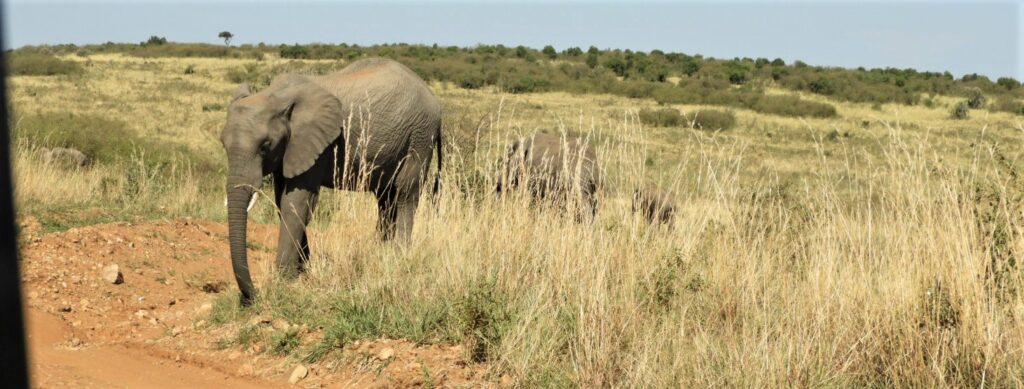
We spotted two more Bush Breakfasts on our way to the plane. First time ever I was close enough to an elephant to observe exactly how one eats; I watched as she pulled grass from the ground and rolled it into her mouth, slow and easy, taking her time.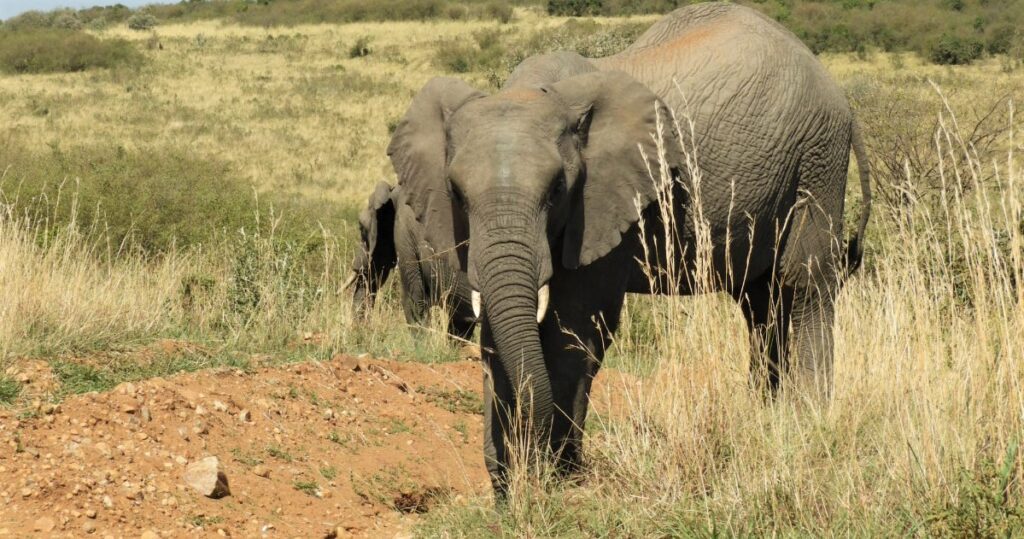
We stayed until the elephant families moved on. And then we passed a baboon family, breakfasting in their own front yard, right there in the beautiful Maasai Mara.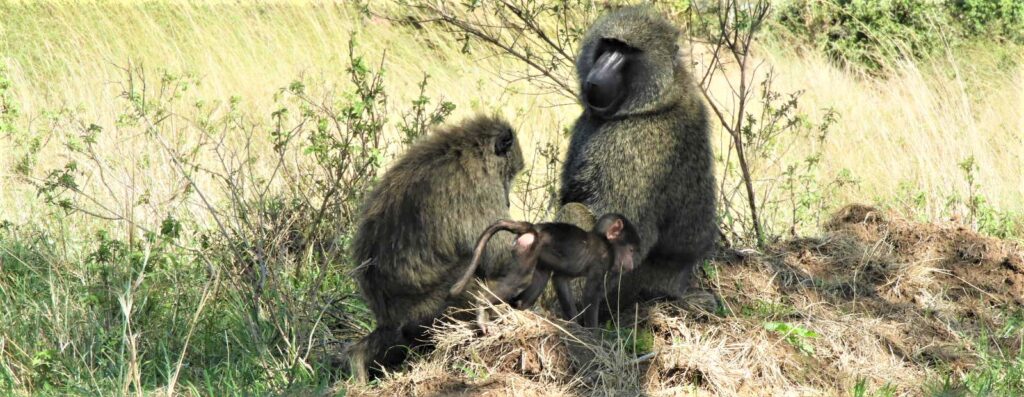
Sarova Mara Game Camp https://www.sarovahotels.com/maracamp-masai-mara/
» posted on Saturday, September 17th, 2022 by Linda Lou Burton
Stay A Little Longer
Linda Lou Burton posting from Sarova Mara Game Camp, Maasai Mara National Reserve, Kenya–– I have only one complaint about my stay at Sarova Mara. It was too short. One full 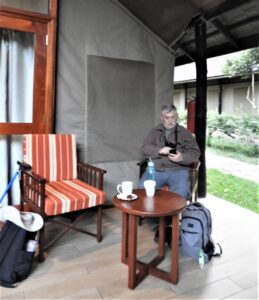 day is not enough time to spend in a unique place like Sarova Mara; I don’t recommend it. Stay long enough to soak it in, smell the roses, twiddle toes in the pool, talk to somebody new, sit on your porch and watch the monkeys watching you. I’m a tad grumpy this morning, not mentally ready to leave. Our luggage was out for pickup before daylight; even before the monkeys were up. We were sitting on the porch sharing a cup of tea till time to climb back in the 4×4 and head out when it hit me – I had no pictures of our tent. I jumped up and quickly snapped some photos, but the beds were unmade, the mosquito nets down; it looks messy but here it is, for memory’s sake.
day is not enough time to spend in a unique place like Sarova Mara; I don’t recommend it. Stay long enough to soak it in, smell the roses, twiddle toes in the pool, talk to somebody new, sit on your porch and watch the monkeys watching you. I’m a tad grumpy this morning, not mentally ready to leave. Our luggage was out for pickup before daylight; even before the monkeys were up. We were sitting on the porch sharing a cup of tea till time to climb back in the 4×4 and head out when it hit me – I had no pictures of our tent. I jumped up and quickly snapped some photos, but the beds were unmade, the mosquito nets down; it looks messy but here it is, for memory’s sake.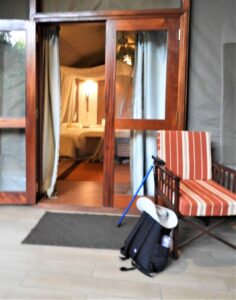
Forgive me for including photos from the net as well as my own so you can see what it’s like at Sarova. Starting with the tents – Sarova has 75, all with a balcony and view. We had a creek and monkey-vine view which we loved; some look out over the plains. The tents range in size from 330 square feet to a 1,400 square-foot family tent. No kidding! Ours was midway, 600 square feet; a king-size bed + a single bed, a 3-compartment bathroom with doors between each section — easy to share space for getting ready in the mornings. Glass panel doors up front with key card entrance, plenty of electrical connections, wifi, all the stuff we’ve come to expect in our everyday lives. Chair with reading lamp, desk, pretty wood floors with colorful rugs. Staff came every morning to unzip all the tent windows and put up the mosquito nets; every night to reverse the action, PLUS, to deliver a flannel-encased hot water bottle — tucked under the covers just where feet go; the water stayed nice and warm for a full eight hours! We had that service at Sweetwaters too — tents are not heated, and the nights can get chilly; the hot water bottles were my favorite of all services offered. (Thinking of getting one for home; also helpful for sore backs, as Rick found out.) Here are other tents much like ours. Note how tents are attached to the permanent overhead structure.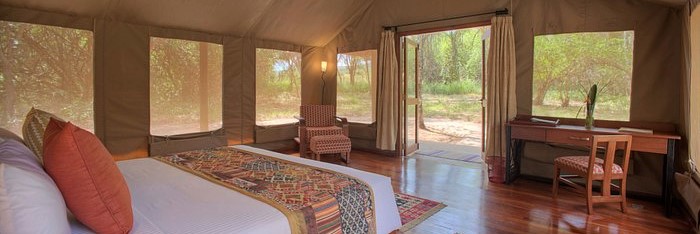
The food and gathering spaces at Sarova – oh my! Check the soaring ceiling in the Isokon Restaurant (below). It’s the same in the Oliop Bar. The décor is like the Mara itself, all open space, sunlight, air. Food stations in every direction, breads piled high, local produce, grilled meats; African style, international too. A server always near, “I’ll carry your plate for you, Miss Linda,” whenever they spotted my cane. That’s our table on the left, second photo. 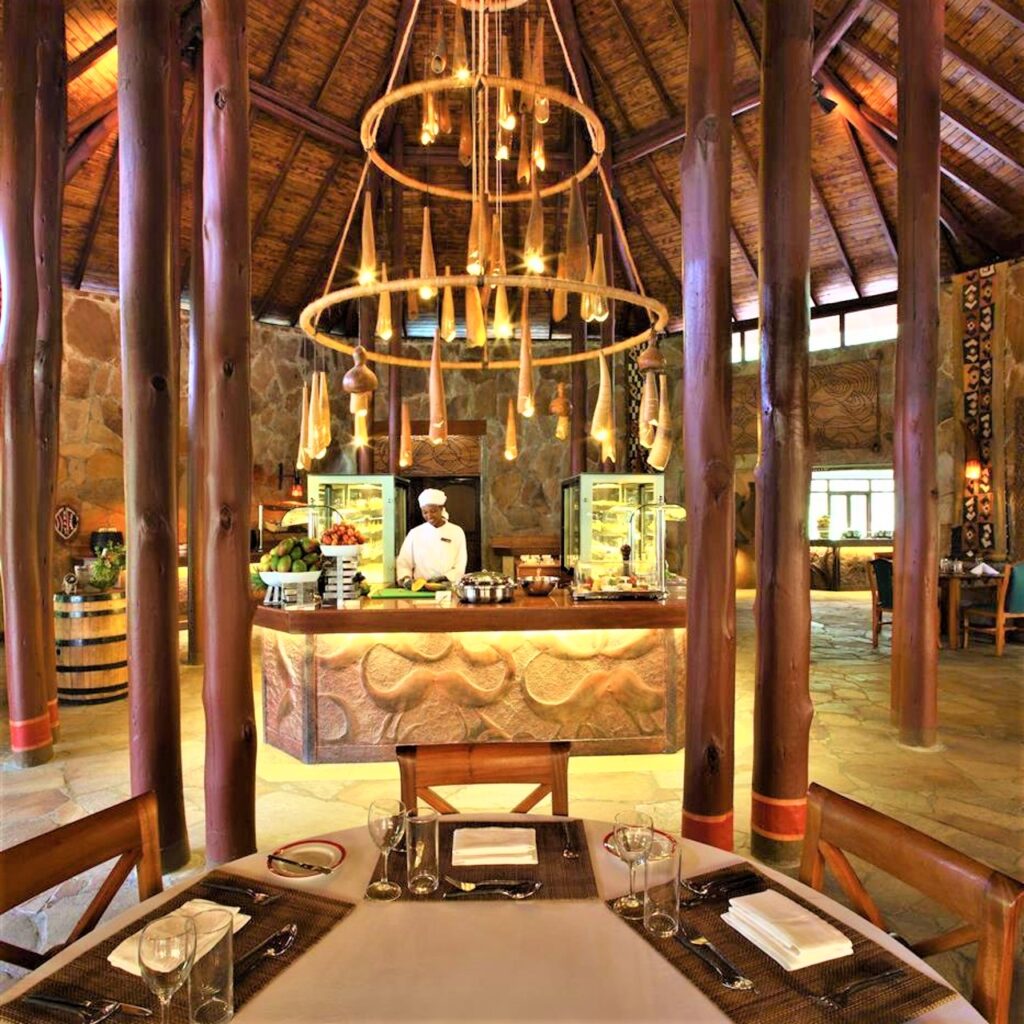
 Sorry I didn’t have time to visit the chef’s garden, plant a tree, maybe even take a beading class. I only went on one game drive! With all the wonder to see in the Maasai Mara, I had only one trip out. Three were offered, true, and the rest of the gang took advantage, but for me bouncing around in the 4×4 both morning and afternoon was not an option – I needed a nap. Darn it, I wish I could stay a little longer!
Sorry I didn’t have time to visit the chef’s garden, plant a tree, maybe even take a beading class. I only went on one game drive! With all the wonder to see in the Maasai Mara, I had only one trip out. Three were offered, true, and the rest of the gang took advantage, but for me bouncing around in the 4×4 both morning and afternoon was not an option – I needed a nap. Darn it, I wish I could stay a little longer!
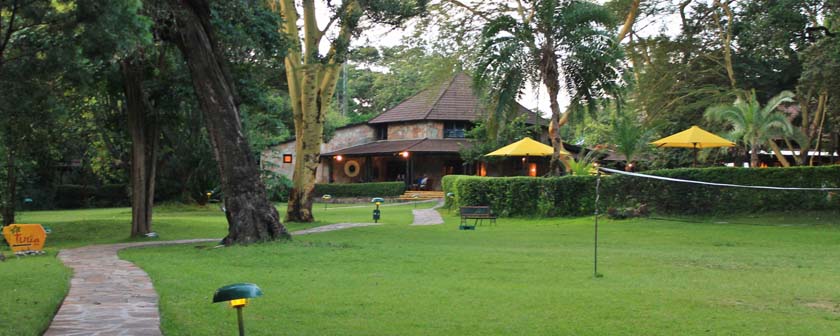 One other thing to mention, they have golf carts going in every direction to give you a lift, great for me and my cane, slowly, slowly (pole, pole). Just remember, when you come here, book at least three or four days. A week would be better!
One other thing to mention, they have golf carts going in every direction to give you a lift, great for me and my cane, slowly, slowly (pole, pole). Just remember, when you come here, book at least three or four days. A week would be better!
Sarova Mara Game Camp https://www.sarovahotels.com/maracamp-masai-mara/

